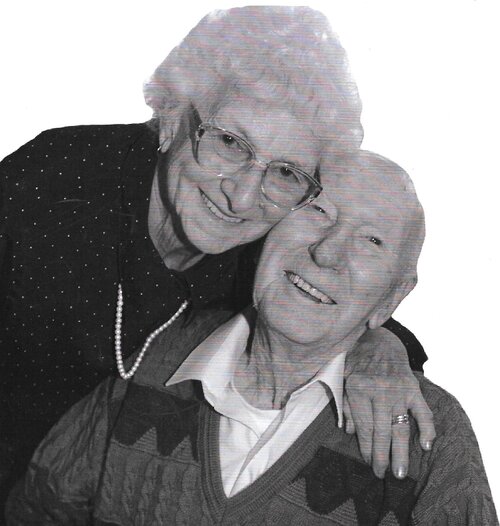George Ernest Edward WARREN (1913-2003) and Iris Ella FORD (1915-2007)
Family Stories > 2nd GENERATION
GEORGE ERNEST EDWARD WARREN
Born 1913, August 16 at home at 443 Malvern Road, Hawksburn, Victoria
Father Leonard Leslie Warren
Marriage 1937, January 23 at St. Matthews’ Church, Prahran, Victoria
Spouse Iris Ella Ford
Occupations
Private Detective, Wade Company
First Aid Attendant, Henderson Springs Works
Painter and Decorator, Warren & Sons
Milk Bar Proprietor, self-employed, Springvale
Painter and Decorator, Warren & Sons
Death 2003, August 1 at East Glenelg, Geelong, Victoria
Age at Death Fifteen days short of 90 years
Cremation 2003, August 5 at Geelong Crematorium, Geelong.
Ashes, together with Iris Ella Ford’s ashes, scattered from pier at Queenscliffe as per their request.
Cause of Death
Renal Failure
Septicaemia
Right Mastoid Infection
Chronic Obstructive Airways Disease
For Iris Ella Ford's Story of her life prior to her marriage to George Ernest Edward Warren - click this link
GEORGE ERNEST EDWARD WARREN
George Ernest Edward Warren was my father - and this is his story. I have taken the time to write down his story so that future generations of our family may know and understand the man who came before them. Understanding your ancestors helps us understand ourselves.
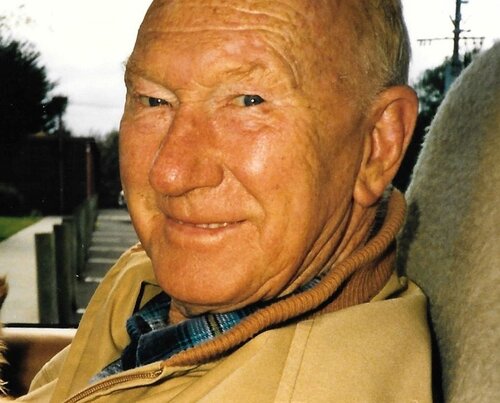 I have written my father's story based on his recollections as told to me several years before he died as well as historical records, such as his journals, letters, documents, photographs, newspaper articles and other items that have found their way into my family history collection. Contributions from various people associated with him have also been included. Wherever possible, I have noted the source of each piece of information.
I have written my father's story based on his recollections as told to me several years before he died as well as historical records, such as his journals, letters, documents, photographs, newspaper articles and other items that have found their way into my family history collection. Contributions from various people associated with him have also been included. Wherever possible, I have noted the source of each piece of information. I have not tried to write a eulogy to him, praising him for all his good deeds and characteristics, but rather to provide a balanced 'warts and all' portrayal of my father, the man. I called him 'Dad', but for the purposes of his story, I will refer to him as George.
As everyone of us has, George had many personas - son, brother, husband, father, boss - to name a few. As a son, George was typical of his generation. He was raised to be respectful and loyal to his parents, Leonard Leslie Warren and Burdett, nee Launder. Over the years, his parents often gave him cause for disgruntlement and disappointment, as most parents do from time to time, but he never defied them or showed them disrespect. He was able to maintain that careful balance between being a respectful son and an independent man.
He grew up with little, if any, affection from his father who was a large man, tall and broad with a strong-will and a heavy hand. He demanded respect and obedience from all his family members, without question. It was George's mother, who doted upon her George, who was left to give him the occasional morsel of affection. Perhaps a smile, perhaps a pat on the back, perhaps an extra piece of meat on his plate was all that George experienced of affection during his child-hood. His mother's nick-name for George was 'Dawdanee'. George always referred to his father as "the old man" and his mother as "ma".
Nevertheless, his family life seems to have instilled George with strength of character and independence. In his recollections, George never remarked about this aspect of his child-hood, taking his lot for granted. It probably accounted for the closeness George had with his brothers, Robert Leslie (Robbie) and Albert Melville (Bert).
Later, after their respective marriages, the brothers drifted apart for months on end. But always there was that unspoken bond between them that was never broken. All the brothers were 'larikans' in their youth, always up to pranks, but not serious enough to be in trouble with the law - or maybe they were just never caught!
All the boys were hard-working - there was no unemployment benefits in George's day, so they had no real choice. All the brothers smoked heavily and all were guilty of imbibing too freely at times, especially at the regular family parties that were a feature during the years 1940 to 1958.
As a husband, George was without peer! He committed himself totally to Iris from 1936 until his death in 2003 - over 67 years. His nickname for Iris was 'Ted' or 'Teddie'. As far back as I can remember, George was responsible for cooking breakfast every morning - usually porridge or eggs. Iris and George developed a happy and workable distribution of family and household tasks with George taking care of all the 'outside the house' jobs, like gardening, lawns, cars, rubbish, whilst Iris managed the 'inside jobs'. Occasionally, there were 'border disputes' - "leave the garden to me - you think everything is a weed!" Iris could be heard to gasp as she surveyed what was left of her newly planted seedlings.
As a father, George's child-hood probably accounted for his inability to openly show affection. I don't remember him ever reading me a story, tucking me into bed, giving me an impromptu cuddle, sitting me on his knee or having a 'heart-to-heart' chat with me. But there was no doubt he loved my brother, Bernie and me. He was extremely slow to anger and he never showed anger or temper to me, no matter how I tried his patience. The closest he came to admonishment was an occasional: "OK, Kate, hop it!" whenever I got in his way or was particularly naughty. He certainly never smacked or hit either Bernie or me.
One of the most difficult times of my child-hood was when I had been caught at something that apparently of momentous badness and mum had threatened "Just wait until your father hears about this!" I cowered in the cupboard in my bed-room for hours waiting - anticipating and dreading the look of disappointment that was sure to be on his face when he confronted me. But, the only recognition he gave of knowing about my fall from grace was a quick look that passed between us that said "Never mind, girl, try better next time!" So I knew he loved me.
He ran Warren & Sons for 30 years (from June 1, 1946 to April 29, 1976), employing many people during that time. He was forthright, truthful, honest, hard-working, fair, conscientious and friendly. His journals record his diligence in paying his labourers even in times of low income. Some of the labourers boarded in the small room at the back of his father's house at 97 Flinders Street, Thornbury whilst they were working for Warren & Sons.
His association with the St. John Ambulance Brigade epitomised all that was good in George. He led by example and did his turn at duty each weekend along with the newest cadet. He established and conducted many of the training sessions held at the Northcote Town Hall each Monday night for years and organised the Annual Dance for the Brigade for more than 15 years.
He loved ballroom dancing and took to the floor whenever he could. He indulged freely in lawn bowls at which sport he became well known as a 'champion bowler' and his friendly easy-going manner made him many long-term friends.
George had a ready smile and a bright open face - he had wavy red hair and blue eyes. One of his key characteristics for which I will always remember him was his refusal to speak badly about anyone who was not present to defend himself or herself. Many are the times George would quietly leave a group when the conversation turned to discussing the bad points of someone not present. As soon as that particular conversation had finished, he would just as quietly return to the group. My son, Jeffrey David Kim, inherited this wonderful characteristic.
Some of his other characteristics were his way of whistling tunelessly whenever he came visiting just to let you know he 'was about'. Whenever he entered a room, he would 'size up' the room as if to quote for a painting job. The amazing variety of 'stuff' he would store neatly in his garage just 'for a rainy day'. His natural use of the 'Australian' slang that rolled off his tongue so easily.
In his last years, George and Iris lived in a unit in Portarlington. It was here that he had an accident with his car that caused him severe injury to his spine. He seemed to lose heart after this accident because he suddenly was unable to do the tasks he had always seen as his responsibility.
Shortly after, George and Iris moved to a retirement village in St. Albans Park, Geelong and concerns about George's eyesight and his safety on the road led to his no longer being able to drive his car.
Then, following a fall at home in which George broke his hip, he was hospitalised and then later transferred to a nursing home. Over the next couple of years, he continued to be bright, cognitive, and happy in spite of the pain and frustration and his increasing lack of mobility. He always held the hope that he would be able to 'go home' soon.
Then just before his 90th birthday, the onset of a particularly virulent infection required the use of very high doses of antibiotics. His body was not able to cope with this treatment and his kidneys began to fail. In spite of all our hopes and prayers, the family knew we were about to lose him.
The last time I visited George was the day before he died. He was sleeping quietly. I wanted to speak to him and tell I was there and that I loved him, but I could only put my hand on his shoulder and hope he sensed my presence. His shoulder was warm and he slept peacefully.
The next night, a phone call wakened me at about three in the morning. It was my brother, Bernie, telling me that Dad had died two hours previously.
George Ernest Edward Warren – His Early Years
1913, August 16 - George’s Birth
George was the second son born to Leonard Leslie Warren and Burdett Warren, nee Launder. He was born on Saturday, August 16, 1913 at the family home at 443 Malvern Road, Hawksburn.
During her labour, Burdett was attended by a mid-wife which was usual in those days. However, she had a long and difficult labour, so a doctor was finally called to assist with the birth. George heard the story of his birth many times during his childhood, and remembers being told that when the doctor saw the newly born infant, all scrawny and red, he instructed the mid-wife to : “Leave the child at the foot of bed. We’d better attend to the mother and save her. That baby won’t survive the night.”
But survive he did!
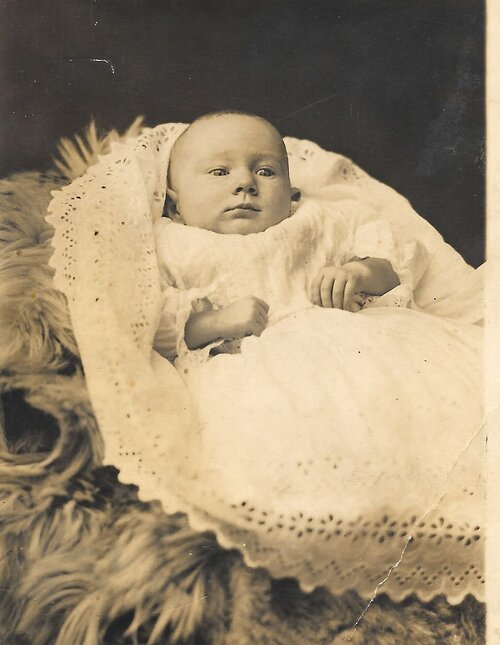

His older brother, Robbie, was thirteen months old at the time of George’s birth and Les and Burdett’s third child, Bert was born thirteen months after George.
1918 - George’s School Days
George’s first school, when he was about five years old, was the Hawksburn State School. Then, only a year or so later, when he was six or seven years old, he and his family moved from Hawksburn to Carrum.
1919 - McLeod Road, Carrum
George’s family moved from Hawksburn to Carrum. George recalls the day the family moved.
“The man turned up with a horse-drawn furniture van with two horses pulling it along. After loading our few odds and sods on board, we set off for Carrum. On the way, we stopped at Mordialloc and had a pie and sauce each. When we eventually arrived at Carrum, we unloaded our things into a rented house - close to the present Patterson Lakes. I forget the name of the street, but it had a doubledecker bus in the backyard, and we had a great time playing in that. “
The family later bought another old house in McLeod Road, near the Carrum railway station. Soon after they moved in, George’s father, Les, decided to build a better house on the block of land, so he set to work to make all the cement bricks for the house.
1921 - Rabbiting at Carrum
George remembers that there were very few houses in Carrum at the time, and empty paddocks were typical of the countryside surrounding Les and Burdett’s house.
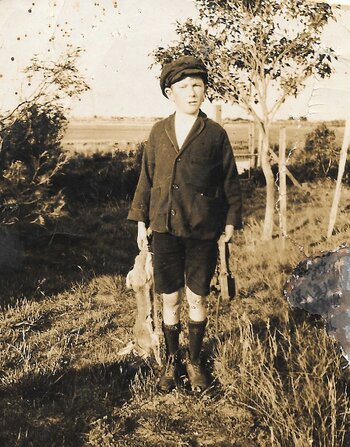 George was then about eight or nine years old and he and his brothers, Bert and Robbie, helped their father make the bricks for their house. But, when he could get away, George would be off across the back paddocks of Carrum to catch the occasional rabbit for the family dinner.
George was then about eight or nine years old and he and his brothers, Bert and Robbie, helped their father make the bricks for their house. But, when he could get away, George would be off across the back paddocks of Carrum to catch the occasional rabbit for the family dinner. George, however, soon got the urge to move up to ‘town’. It is not clear whether his ‘urge’ had anything to do with the family labour of brickmaking and his need to avoid it! He swears not!
Nevertheless, Les, Bert and Robbie continued to labour over the brickmaking in George’s absence, and eventually, Les finished the house. It was a good solid family home, complete with picket fence across the front boundary, casement windows with lead-lights, and a front veranda with cement columns. Les named the house “Kaniva” after the north-western Victorian town where he was born and had grown up with his family.
The Warren family house in Carrum didn’t have a street number. There were so few houses in Carrum at the time, the only postal address that was required was :- “Kaniva”, McLeod Street, Carrum.”
1921 - George Moves to Granny Launder’s
Having moved to ‘town’, George lived with his mother’s family at 720 High Street, Armadale. He lived with his maternal grandmother, Mary Burdett Launder, nee Salisbury and her children, Harry, Dick, Robert and Gertrude. George’s grandfather, Roberts Launder had died in 1910. Also living with the family was Gertrude’s son, “Tiny”.
It was from the shop at this address that George’s Uncles, Dick and Bob Launder operated a sign-writing business and a painting and decorating business. His Grandfather, Roberts Launder, had died in 1910, and George’s Granny Launder lived with the family at the rear of the shop in High Street.
1921 - Armadale State School
Now that George was living in town with his Granny Launder and her family, he transferred to the Armadale State School where this class photo was taken. George is in the front row wearing a watch chain.
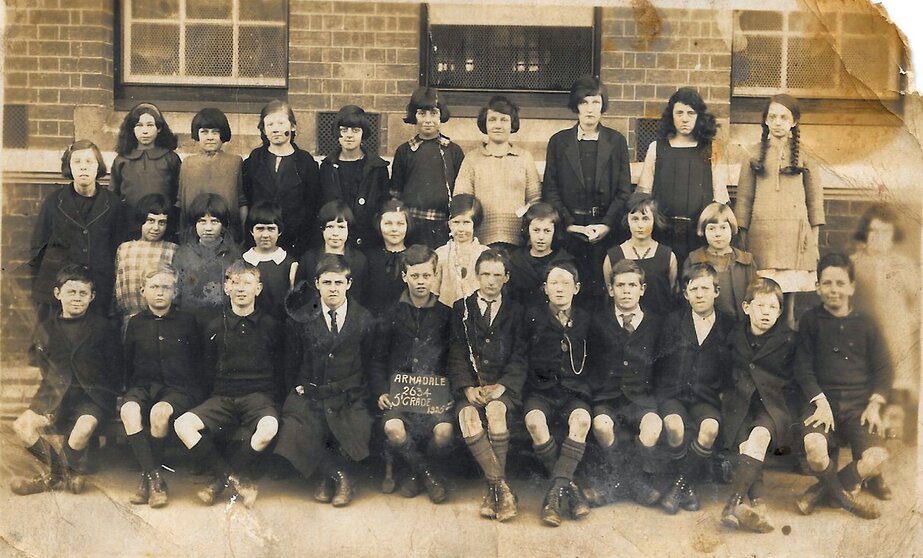
1927 – George’s First Job
The influence of his older uncles and cousin may have convinced George that school was not for him. When he was about six months short of his fourteenth birthday, George decided it was time for him to leave school, and he got a job at a local chemist shop as a bottle washer. He had not been long at his new job and was enjoying his newly gained independence when the school headmaster came into the shop and spotted him.
George recalls the headmaster glaring at him and asking why he was not at school. Quick-witted George responded confidently enough and informed the headmaster that he had left school! But the headmaster was not to be ignored and eventually, back to school George went - but only until he had reached the legal school leaving age fourteen years old - six months later.
George spent most of his spare time with his family, both the Warrens and Launders.
1927 - Delivery Boy at Launder’s Jewellery
George’s next job was with an uncle (Horace Percival LAUNDER) (although at the time, neither realised they were related). The uncle had an importing business at 301 Flinders Lane, Melbourne, importing jewellery which he then sold to various stores around Melbourne, including Coles.
George was the delivery boy, and he pushed a wicker basket filled with goods through the streets of Melbourne. Sometimes, he would ride on the cable tram to go to the Coles store in Smith Street, Collingwood to deliver a parcel of jewellery.
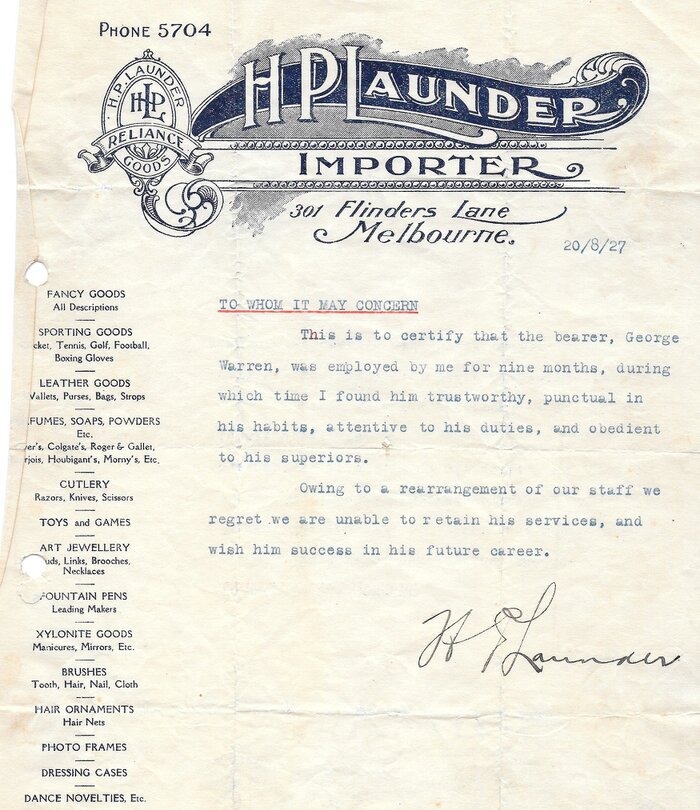
George worked at that job for about twelve months, until he was told there was no more work for him. On hearing this news, George’s father, Les, paid the importer a visit to find out why George had been put off. During their conversation, it became apparent that George and the importer were related, which had not been realised previously. The upshot was that George was offered his job back, but, by then, he had decided to move on anyway! And this was his reference.
1928 - Mackay’s Harvester Works
Another of his uncles, Lloyd (Lloyd Loch Warren, was working at Mackay’s Harvester Works in Sunshine. Lloyd suggested George join Mackay’s to learn the turning and fitting trade. So, George applied for and was given an apprenticeship on three-month probation to learn the trade.
To make it easier to access his new workplace, George moved in with another cousin, Noel Skene at Deer Park. Noel was the son of George’s Uncle Harold and Auntie Susan (Susan Burdett Launder). This move then meant that George had to ride his push bike from Deer Park to Mackay’s workshop in Sunshine every day. However, after the probation period, George chose not to continue his apprenticeship and again left the job to seek his fame and fortune elsewhere
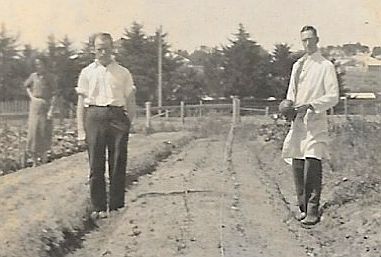
C 1928 - Strawberry Farming at Sylvan
During this time, George’s father, Les, owned land at Sylvan where the family lent a hand at farming strawberries.
1929 – Return to Carrum and Stolen Bicycle
George was now about sixteen years old, and he returned to live with his family at Carrum. On November 16, 1928, his bicycle was stolen, and order was made out the Malvern Court on January 19, 1929, against Roy Dawson and E. Ryan to pay six pounds to George in compensation for the stolen bike. Payments for this larceny were made to George through the Malvern and the Carrum Police Stations over the next two years and these payments were faithfully recorded in George’s journal, named “G. E. Warren, 2nd General Ledger, McCleod Road, Carrum”.
1930 - Pacific Cable Board
On February 7, 1930, George started work at the Pacific Cable Board. He had to wear a smart uniform and cap in this job, and he had to deliver cablegrams and telegraph messages around Melbourne. He travelled by train from Carrum to Melbourne every day - a monthly train ticket costing him “two bob” or two shillings. Towards the end of his stint as a delivery boy in about 1930, a newspaper photographer snapped George and three of his mates “during their lunch-hour interval at Victoria Dock swinging on the hawser of the Port Auckland.” George is at the back.
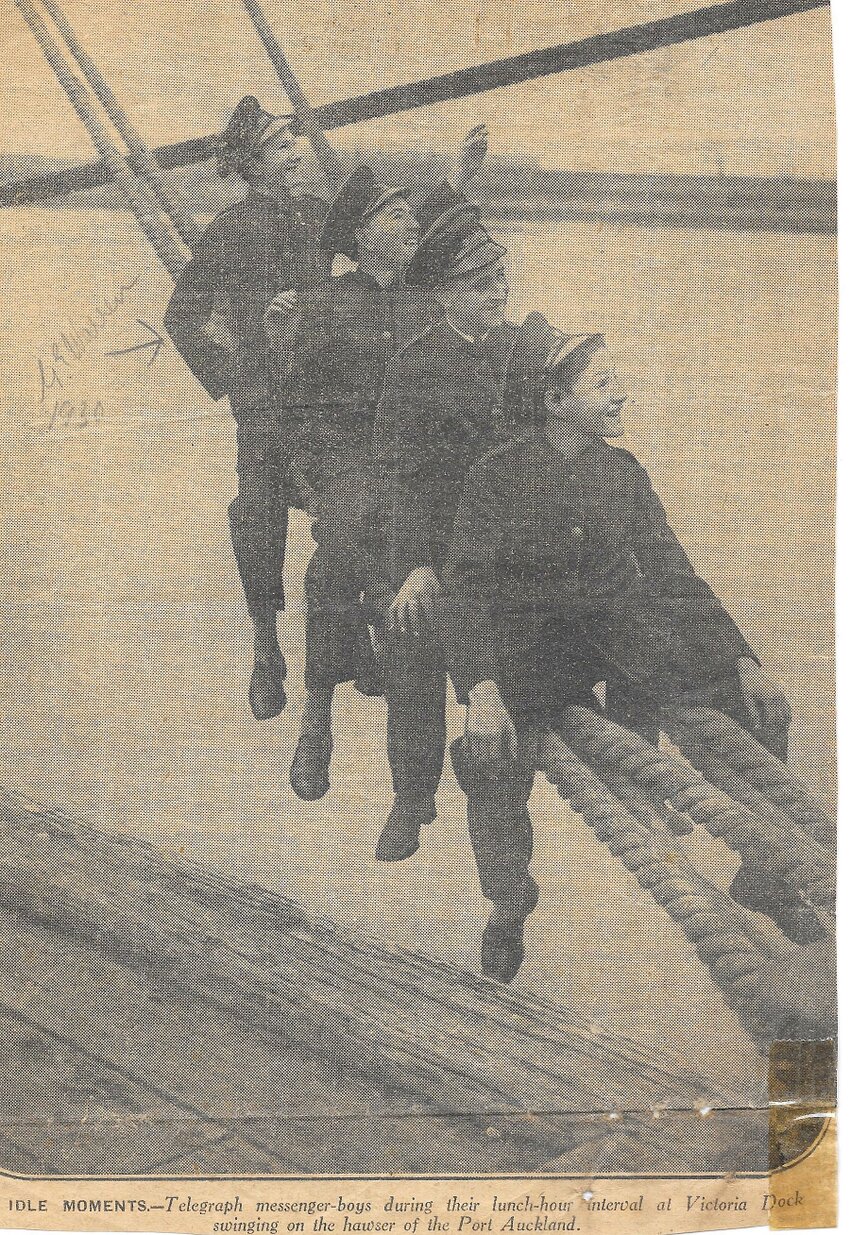
This job lasted for nearly two years, but eventually he decided to leave because the job involved a lot of shift work and week-end work.
He resigned from the Pacific Cable Board, receiving his last pay on November 6, 1931. During his time with Pacific, his average weekly pay was about one pound and five shillings and in total he earned one hundred and twenty pounds, two shillings and nine pence, all neatly recorded in his journal.
1931 – Purchase of Motor Bike and His Bike Licence
When he was “going on eighteen “, George bought a motor bike. It was his pride and joy. It was a belt-driven Douglas, registration No. 20.879. The head light was an ingenious gas lamp which consisted of an acetylene cylinder to which was added carbide pellets and water. This process produced a gas vapour which could then be ignited with a match.
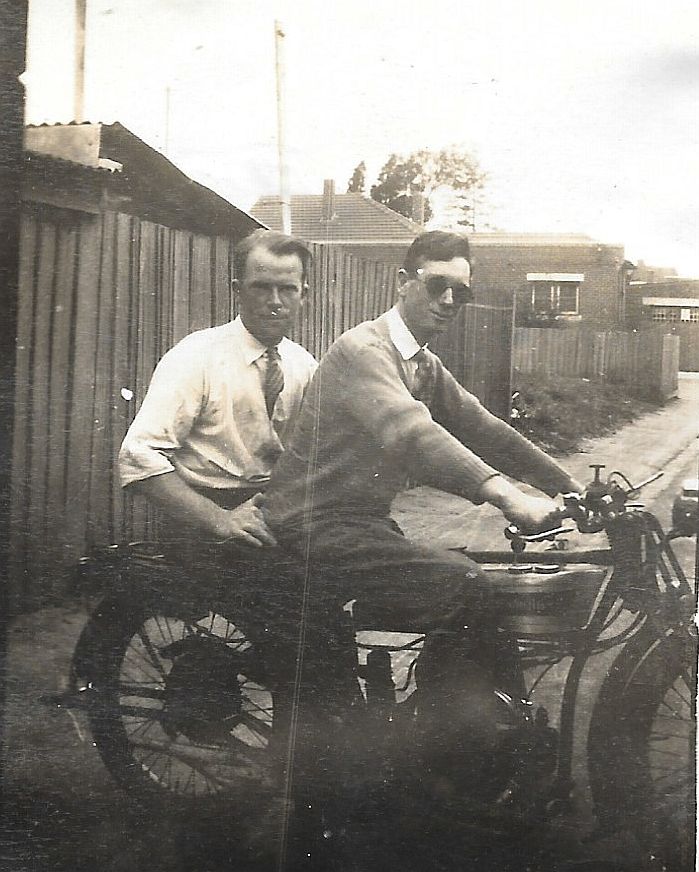
Next thing he needed was a bike license! So, he went to the Exhibition Buildings to complete the license test. The policeman who tested him told him his test was successful and that he had qualified for a license. Then, as an afterthought, he asked George his age. Well, George figured that he was almost eighteen, so therefore it was almost alright to say:- “I’m eighteen, sir!”
But the policeman eyed George with suspicion, when, having asked to see a birth certificate, George’s quick response was that he did not have it with him. Maybe the policeman thought George was just a little too quick with his assurance, so just as quickly, the policeman told George to bring the birth certificate with him next time he was in town. He refused to give George a license until then.
Disgruntled, but undefeated, George headed home to Carrum. On the way, he called into the Chelsea police station to try again for a motor bike license. He had much better luck there, because the policeman simply asked him to ride down to the end of the street and back again. The policeman then declared that George could handle the bike OK, asked for two shillings and six pence and gave him a bike license - birth certificate unseen!
So, in mid-1931, George thought he was pretty clever getting his motor bike license when he was only seventeen years of age! He was then able to ride his motor bike between Carrum and Melbourne, which was much better than travelling in the train.
The photo shows George riding his bike with his cousin "Tiny" Launder his passenger.
1929-1932 – Depression Hits Australia and The Knitting Trade
The Depression began with the Wall Street Crash of 1929 and rapidly spread worldwide. As in other nations, Australia suffered badly during the period of the Great Depression of the 1930s, suffering years of high unemployment, poverty, low profits, deflation, plunging incomes, and lost opportunities for economic growth and personal advancement.
During this time, Australia’s unemployment reached a record high of around 30% in 1932. George had a job working at Crundell’s Knitting Mills, located over the top of the Prahran market where he learned the knitting trade on a “flat machine”. He enjoyed the job then decided to leave, purchase a couple of knitting machines at a good price and set up his own knitting business, working initially out of his home at Carrum, then out of a shop he rented in Bridge Road, Richmond.
Unfortunately, although he made some profits, the knitting enterprise was not as successful as George would have liked. He recalls that at the time the Japanese were importing finished goods cheaper than George could buy the wool and the depression had a significant impact on people’s ability and/or willingness to purchase.
1933 - Social Life
Les sold the family house at Carrum and moved “up to town” to live. They moved into a house at 2 Burnley Street, Richmond and there George continued to live with his parents, Les and Burdett, and his brothers, Robbie, and Bert.
Life was fairly difficult for the family, but this did not seem to deter the young George from making the best of his teenage years. He continued to enjoy the closeness of his Launder relatives, who remained at the shop at 720 High Street, Armadale. George would often move back with the Launders at Armadale and spent a lot of time in the company of his cousin, “Tiny”.
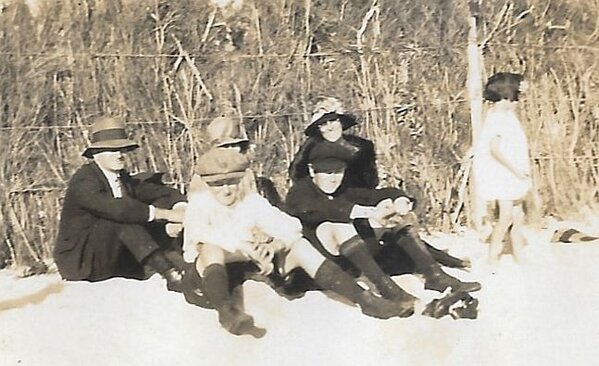
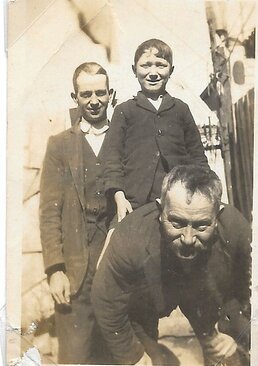
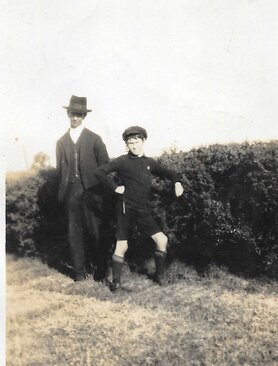
They would often part with a six-pence and see a film at one of the local picture theatres, like “The Lyric Theatre” which was in Chapel Street, Prahran, near the corner of High Street. They also patronised “The Royal Theatre” further down the road in Chapel Street, Windsor, near the railway bridge, and occasionally, they went to “The Empress Theatre” in Chapel Street, Prahran.
Serious relationships with girls did not play much of a part in George’s life at this stage. He sometimes tagged along with “Tiny” when he walked a girl out. But often as not, “Tiny” would wink at George, ask him to ‘keep nit’ for him, before ducking into a quiet laneway with the girl for about ten minutes or so. “Tiny” and his girl would then re-appear to continue their stroll down Chapel Street with George. Sometimes, the girl would nuzzle up to George and smile promising that his turn would come one day.
1933, August - Hoyts Theatres Advertising Department
George worked for Hoyts where his average pay varied between one pound, and two pounds, four shillings per week. He resigned from this job on January 23, 1934, earning a total of twenty-nine pounds and twelve shillings.
By this stage, George was a tall, slim, handsome young man. His hair was a dark carrot-colour. It was naturally curly as was his mother, Burdett’s hair, but he kept it cut short so that his head was covered in a mass of tight waves.
1934 - 119 Derby Street, Kew
George’s family moved from 2 Burnley Street, Richmond to 119 Derby Street, Kew.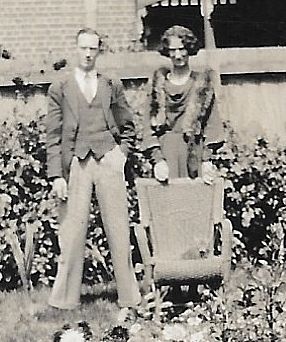

1934, January 26 - Samuel Travers Knitting
George started work for Samuel Travers Knitting Manufacturers of 84 Chapel Street, Prahran. His average weekly wage was one pound, eighteen shillings, earning him a total of fifty-two pounds, ten shillings and nine pence by the time he resigned on October 26, 1934.
1934, October 26 - Dunlop Rubber Company
Having terminated his employment with Samuel Travers, George immediately began service with Dunlop Rubber Company of Abbotsford. His first job with Dunlop was sweeping the floor in the vulcanising room, which earned him three pounds, eleven shillings and four pence each week.
By December 10, 1934, he was transferred to the mill room working the milling machine where his salary varied each week but averaged about the same as when he had started at Dunlop.
His journal records that, for the year to June 30, 1935, he earned one hundred and twenty-two pounds, eighteen shillings and six pence. He finished working at Dunlop on November 1, 1935.
End 1934 - 50 Burnley Street, Richmond
George and his family moved from 119 Derby Street, Kew to 50 Burnley Street, Richmond. George’s father bred puppies and George helped.
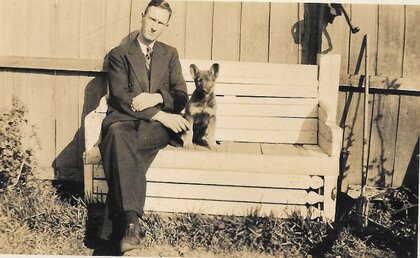
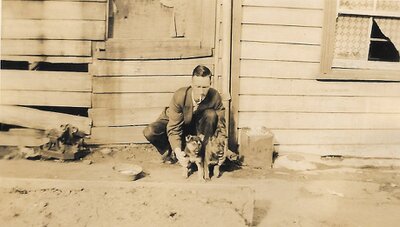
For Iris Ella Ford's Story of her life prior to her marriage to George Ernest Edward Warren - click this link - then come back to the story of their life together
George meets Iris
End 1934 - The Hewitts
George and his family, and Daisy Montgomery and her family went on holidays to Warburton together. It was whilst they were on these holidays that the Warren family first met Clara and Harold Hewitt. (Clara Hewitt, nee West, was sister to Sarah Jane West, mother of Iris Ella Ford).
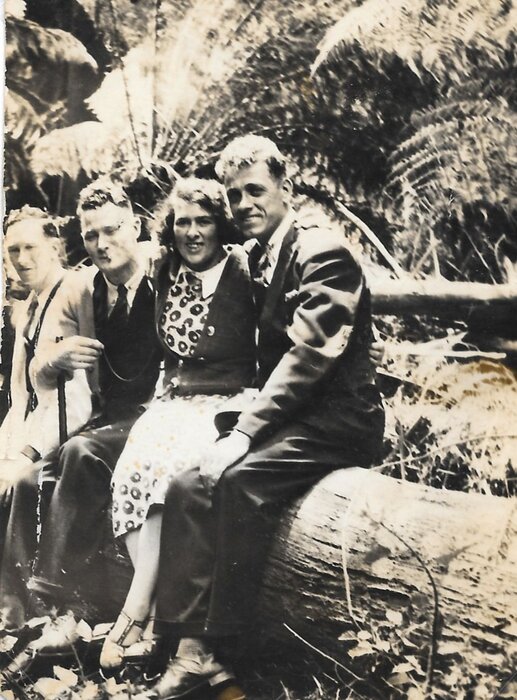
Now at the time, Harold had a friend by the name of Cecil Blewitt and Cecil had accompanied the Hewitt’s on their holiday to Warburton. Everyone seemed to get on very well, but to George’s dismay, before the Warburton holiday of 1934 had ended, Cecil had won the heart of George’s fair Daisy. It was understandable that at this point, George was “off girls for a bit”.
However, the link between the Hewitt family and the Warren family had been made.
George was undoubtedly a good-looking young man with his dark red hair and open smile.
L to R : George Warren, Robbie Warren, Sarah and Harold Hewitt
The two families, the Hewitts and the Fords were to spend several more holidays together, one a shooting party at Warburton, another at Clematis.
1935 - Match-Making
Clara Hewitt’s sister, Sarah Jane, nee West, was married to George Dixie Ford and they had two daughters, Iris and Irene. Clara thought the two Warren boys, George and Robbie, were extremely nice, and therefore very eligible bachelors, worthy of introduction to her two nieces, Iris and Irene. The third Warren brother, Bert was already married at this stage to Kathleen May McCormack.
By March in 1935, Clara’s sister, Sarah was working at “the jam factory” and suggested that Clara and Harold attend “the jam factory picnic” that was to be held at Queenscliff. It was planned that Clara would introduce Iris and Rene to the “two nice Warren boys” she had recently met at Warburton.
Apparently, Clara had intended Iris to match up with Robbie, but at the last minute, Robbie had to work and was not able to get to the picnic, so, George arrived with his cousin, Les Launder in Robbie’s place.
We must not forget that George was newly recovering from his broken love-affair with Daisy Montgomery and was still feeling emotionally bruised. It is therefore not surprising that he was not exactly excited at the prospect of meeting another girl so soon after his recent disappointment.
When the day of ’the jam factory’ picnic arrived, the Fords (George, Sarah, Iris and Rene) met the Hewitts (Clara, Harold and their children, Unis and Arthur) and the Warrens (George Warren and Les Launder) at the Port Melbourne pier. There they all boarded the ferry “The Weeroona” for the trip across the bay to Queenscliff and the picnic.
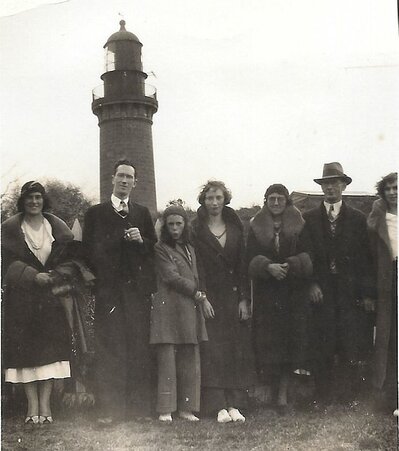
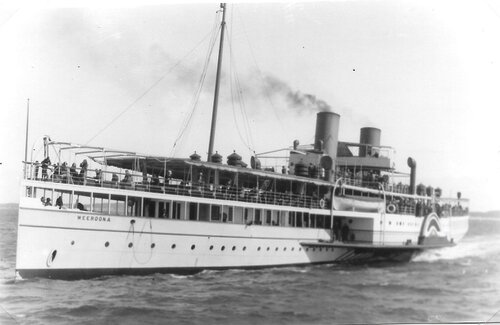
L to R : Clara Hewitt (nee West), George Warren, Unis Hewitt, Rene Ford, Sarah Ford (nee West), George Ford, and Iris Ford
And the good ship "Weeroona"
The ferry trip and the picnic at Queenscliff were pleasant enough, but the match-making plans looked unlikely to eventuate.
Iris was not particularly interested in the fellow called George, nor it seemed, was he interested in her. The two girls, Iris and Rene, spent the day together, hardly even noticing the two boys – or maybe the girls were just shy? Anyway, at the end of an uneventful day, the party took the ferry back to Princes Pier for the train trip to the city.
George was living with his family at 50 Burnley Street, Richmond. So, having arrived back at Princes Pier, the party travelled together in the train back to the city. There they were to part company and catch their separate trains and trams home.
The train that evening was very full and the passengers tightly packed. Iris found herself strap-hanging, and George found himself strap-hanging directly behind the lovely Iris, who was of course, wearing her heavy overcoat. Every time the train bumped and rattled, George found himself bumping into the girl whom he had hardly even noticed during the day. And with every bump and rattle, George’s ‘interest’ was further aroused.
By the time the train reached the city, George had developed a fine appreciation for the nether regions of the delectable Iris, and he wondered if he had been too hasty in his judgement of her during the day. Perhaps her overcoat had hidden a lot of her qualities and her potential! Perhaps, he had better see her again to re-assess the situation!
1935, April - The First Date
In the Autumn of 1935, a family afternoon was arranged at the Botanical Gardens in Melbourne. Clara and Harold, their children Unis and Arthur, together with George, Robbie, Iris and Rene strolled about the gardens together, afterwards relaxing on the grassy slopes in the warm sunshine. Several photographs of the group were taken during the day - perhaps the significance of the day was not lost to them. Not only did George get to know Iris much better, despite her bulky overcoat, but Rene met Robbie for the first time as well. Nevertheless, the young people were chaperoned by their aunt and uncle, Clara and Harold Hewitt and their children.
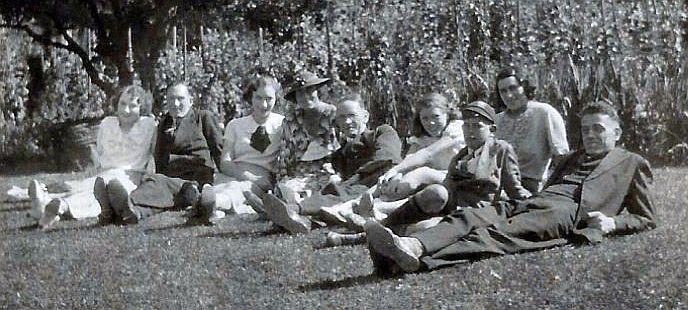
L to R : Iris Ford, George Warren, Rene Ford, Sarah Ford, George Ford, Unis Hewitt, Arthur Hewitt, Clara Hewitt, Harold Hewitt
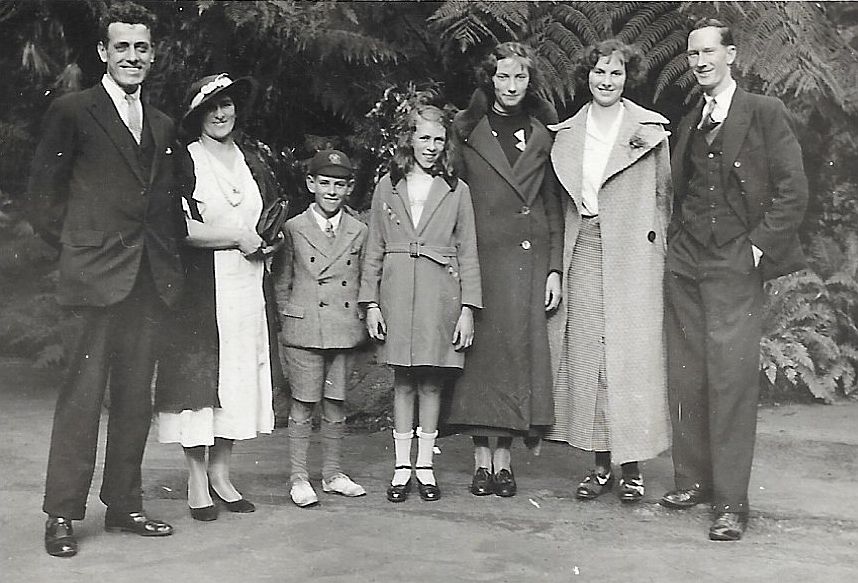
L to R : Harold Hewitt, Clara Hewitt, Arthur Hewitt, Unis Hewitt, Rene Ford, Iris Ford, George Warren
Courting for the Warren boys and the Ford sisters was a stroll up Chapel Street, Windsor, or a trip to the movies. George and Robbie would arrive together at the Stewart Street house to collect Iris and Rene. They would then stroll in opposite directions with their respective girls. Iris swears it took her months to understand why George would hurry like mad to walk around the block with her. It seems that the first couple back from their stroll got to the sofa first!
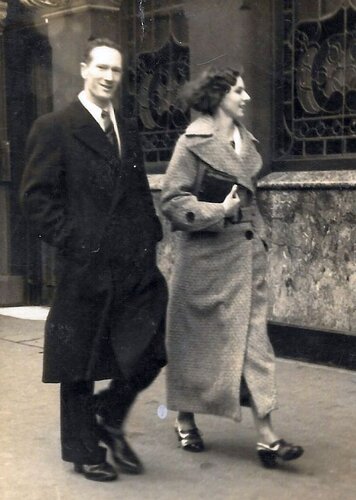
Mind you, Iris also swears that her total sex education at that stage in her life was, “If you let a man put his arm around your waist, you’ll get pregnant!”
1935 - Philip Wade Private Investigating Services
George was working as a private detective for Philip Wade Private Investigating Services of Melbourne, along with his brothers, Robbie, and Bert. Between assignments, the boys would help at the Wade house in Brighton. This photo shows Bert, Philip Wade and George working on the Wade house in Brighton.
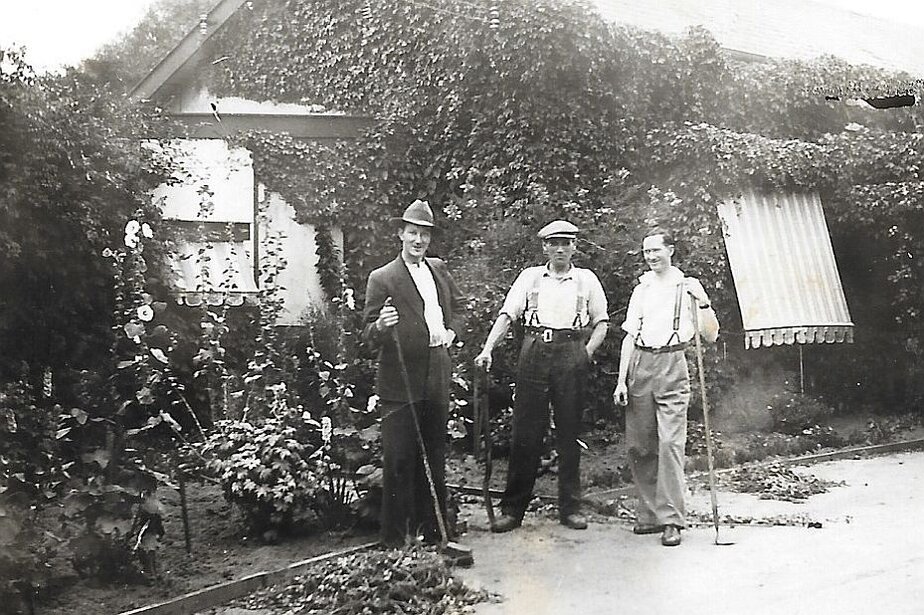
Combining work and pleasure, one of George’s favourite ploys at this time was to take Iris out for a walk or a tram ride - innocent enough, one might say, but he was working as a private detective, following, and spying on suspects, without telling Iris, and using Iris as part of his cover.
1935 - First Proposal
Despite this, or maybe because of this, George managed to get Iris into the front seat of his father’s Dodge sedan car, which was parked in his father’s garage. George proposed marriage to the lovely Iris, but Iris refused George’s offer. She felt she was being pushed into the relationship and was not all that sure she was even keen on George.
1935 - May 22 - Iris’ Birthday Present
It appears that at some stage in the early part of Iris and George’s courtship, Clara whispered into Iris’ ear that when George had been keeping company with his previous girlfriend, Daisy, he had given her a lovely wristwatch for her birthday. It was easy for Clara to presume, therefore, that George was quite rich, and she encouraged Iris in this expectation also. So, when Iris’ birthday drew near in 1935, she began to get quite excited at the prospects of a lovely birthday present from George. But, to her dismay, he told her he was going to knit her a sweater on his knitting machine for her birthday.
Of course, George needed to know Iris’ measurements for this sweater. But the shapely Iris, still shamefaced at having been told her breasts bounced when she walked, deliberately understated her measurements. So, when the sweater was finished, it fitted as tight as a stocking! Iris remembers that it really was a very lovely sweater, but about three sizes too small!
1935, December 5 - Ford Motor Company
One of George’s first assignments whilst working as a private investigator was at Ford Motor Company in Geelong. In this position he operated under the guise of a store man, whilst conducting his private detective investigations. This job required him to move to Geelong and he took a room at The Sydney Hotel in Geelong for one or two days before finding accommodation at 27 Aberdeen Street, Newtown, Geelong.
On December 5, 1935, he wrote to Iris, addressing his words to ‘Darling Iris’ from The Sydney Hotel, having just arrived by train in Geelong. He was in great haste, having to plan to start work at Ford the next day, and to get himself a suitable boarding house as soon as possible.
He signed his letter, ‘Yours most lovingly, George’ with lots of kisses. Things were definitely looking up!
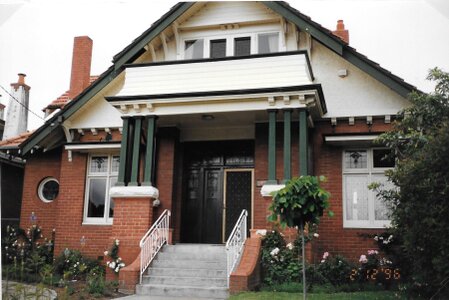 1935, December 6 - 27 Aberdeen Street, Newtown, Geelong
1935, December 6 - 27 Aberdeen Street, Newtown, GeelongThe very next day, on December 6, he wrote to his “Darling Iris” from his new boarding house at “Frednor”, 27 Aberdeen Street, Newtown, Geelong.
1935, Christmas - Warburton
During this time, his family moved from Derby Street, Kew to 50 Burnley Street, Richmond.
At Geelong, George kept himself busy, working until nine o’clock most nights, and was looking forward to having ten days off at Christmas, because the Ford, Warren and Hewitt families were planning holidays at Warburton.
Iris’s mother, Sarah, was in and out of various hospitals throughout this period as her asthma was worsening. Both Iris and George referred to Sarah’s illness and her hospitalisation in their many letters.
Christmas at Warburton with their families Christmas, 1935. was all too soon over and George had to hurry back to Melbourne. He was quite impressed with the ‘service car’, a kind of taxicab, that took him back to Melbourne. It did ‘55 miles per hour all the way’ and it only took one hour and ten minutes from Warburton to Melbourne!
Back in Melbourne, George went to Brighton for dinner with his boss, Mr. Wade, then visited his Grandfather Warren (Charles James WARREN) in the rest home where he was living, then took the train back to his boarding house in Geelong.
1936, January - Week-end Visits Only
Throughout the period December in 1935 to late January 1936, George lived quietly at the Aberdeen Street boarding house and worked lots of overtime. He still found time to visit the Geelong Theatre, seeing such films as ‘Dante’s’ Inferno’ and ‘The Last Outpost’, and wrote two and three letters each week to his ‘Darling Iris’, who returned an equal number of letters to ‘My Darling George’. George caught the train back to Melbourne to see Iris as many weekends as he could manage.
George commented on the King’s death in his letter of January 21, 1936 and wondered whether they would get a holiday on the day the King was buried. He also mentioned his concern that Ford was putting men off, but he hoped his job was safe.
1936 - George Proposes Again
On one of these weekends, George, who had never given up heart, proposed a second time. Iris was just twenty years old when she finally accepted his proposal of marriage. Who could have resisted him?
1936, January 28 - 384 Ryrie Street, Geelong
Then George wrote that he was “shifting to another boarding house tomorrow” because the board at the new house was only one pound, two shillings and six pence - five shillings cheaper than at Aberdeen Street. On January 29, 1936, George moved his belongings to his new boarding house at 384 Ryrie Street, Geelong.
This economy was no doubt in view of his future expectations. His January 28 letter told Iris that he would be coming up from Geelong to see her the next day.
But life was not as simple as the two lovers would have liked. Sarah’s health continued to worsen, and she was spending more and more time in hospitals, not all of them easily accessible to her family.
1936, March - Wedding Plans are Changed
The relationship between Iris’s father, George Ford and George’s father, Les Warren, was not always smooth. The two men had completely different personalities, George being English, quiet, introverted, and thoughtful, whilst Les, an Australian, was loud and used to having people follow his orders without too many questions.
The months of early 1936, were troubled times, as George and Iris tried to make plans for their marriage. Sarah did not want to miss her daughter’s wedding, but the times were now rare that she was not confined to some hospital bed in some part of Victoria. Iris’s father, George had only the Hewitt’s as relatives in Australia and only a handful of friends he wanted at Iris’ wedding. George’s father’s family, on the other hand, was large, and although close contact had not been kept with a lot of his Kaniva family, he insisted they all be invited to his son’s wedding.
End March 1936 - The Engagement Ring
Finally, towards the end of March, 1936, George wrote to Iris to tell her that he would have to buy her ring in Geelong, “because I have discovered that there is no way of getting the money to Melbourne in time for Saturday.” And Iris would have been disappointed if she did not get her engagement ring the next weekend when George visited her! But, as it turned out, the ring was not the right size, so had to be taken back to Geelong for alterations. Iris was finally able to wear her engagement ring at the beginning of April 1936. In fact, George did not select and purchase the ring, but left that job to his mother, Burdett!
1936, April 24 - George out of Work - Back to Melbourne
For George, job prospects were about to turn bleak. He lost his job at Ford’s in Geelong where he had earned a total of fifty-eight pounds. He then moved back to his family in 50 Burnley Street, Richmond and sold his Douglas motor bike for extra cash.
1936, May 6 - “St.Elmo”, 97 Flinders Street, Thornbury
But, when George arrived home, the Warren’s were in the process of moving house from 50 Burnley Street to 97 Flinders Street, Thornbury George helped them take up lino from the Richmond house and re-lay it in the new house at Thornbury.
The Warren’s finally moved into Flinders Street on May 6, 1936. The house was named “St. Elmo”.
It was a single-fronted weatherboard house, typical of the period. From the heavy front door with its glass inserts, special guests were ushered down the hallway and into the first door on the left to the ‘front room’. The ‘front room’ or ‘best room’ was rarely used and filled almost to over-flowing with heavy furniture - crystal cabinets, a lounge suit, occasional tables, side-boards - with lace antimacassars on the chair backs, lace curtains at the window and Burdett’s best ornaments, crystal and crockery displayed on every available surface. The ‘front room’ was only ever used for entertaining special guests or for more sombre events, such as funerals. Generally, George and his two brothers were forbidden entry to this room, as were all the grandchildren who followed in later years. To the right of the front door was Les and Burdett’s bedroom which over-looked the small front garden.
The long narrow hallway was divided into “front” and “back” hall by heavy double-sided crushed velvet drapes hung from brass rods at the ceiling and caught at each side to the wall by heavy ties. The drapes were dark burgundy at the ‘front’ and a soft beige at the ‘back’. The floorboards in most of the house were ‘black-Japanned with heavy carpet squares and carpet runners in the hallway.
In the bedrooms, there were high iron-framed beds covered with down-filled eiderdowns and heavy white damask bedspreads. Heavily starched white embroidered linen pillow-shams covered the pillows, and the sheets were always white linen which had been lightly starched and ironed. Under each bed was a china chamber-pot, usually beautifully decorated with painted roses, and over which Burdett kept a square of heavy white linen to keep unpleasant odours contained until the pot was emptied in the mornings.
At the end of the hallway, one entered the kitchen, the dominant feature of which was the large black iron wood stove, on which Burdett would heat the dashing-irons. She would test their heat by brushing her wetted finger against the plate. When her finger sizzled, the irons were ready! There was also a very large timber kitchen table at which eight people could easily have been seated as well as a glass fronted kitchen dresser, an ice-chest, and other miscellaneous cupboards.
The dining room had an even larger table - a claw-footed dining table with matching chairs at which ten people could sit.
The laundry, which was housed in a separate building at the rear of the house, was equipped with the usual wood-fire copper, concrete troughs, washboards, airing racks, and timber shelving. Burdett covered the mantle-piece above the kitchen stove, the shelves in the pantry, and the shelves in the laundry with lengths of newspaper which she cut to fit and then decorated by cutting a neat saw-toothed design along the front edge.
Mondays was always Burdett’s wash-day, and her gleaming sheets would almost fill the back garden as they flapped in the breeze from her clothes line - two ropes strung between tall posts, with long poles used as ‘props’ at the centre point of each rope to keep the washing from dragging on the ground. And Tuesdays in Burdett’s house were always ironing days.
Milk for the household was purchased from the dairy in Mansfield Street, which was just around the corner, running parallel to Flinders Street. Burdett would put on her best dress and best shoes and set off with her small billy and lid to the dairy. The dairyman kept his milk supply in a large milk urn beside his shop counter, without any kind of refrigeration. When a customer wanted to purchase milk, the man would remove the lid from the urn, un-hook his long-handled ladle from the side of the urn and ladle out the required milk into the customer’s container. Two ladles would fill Burdett’s billy, and for this milk she would pay about six pence.
1936 - The Search for a Job
George was busily looking for a new job and his ‘supply of surplus money’ was nearly ‘exhausted’. His boss, Mr. Wade, had talked about sending George to Sydney on his next assignment, but this had fallen through. There was a possibility of a Melbourne job, but in the meantime, George continued to look for other work. He went to various knitting mills in search of work and finally started at a temporary job in a factory in Swanston Street, Carlton on May 12, 1936. Throughout these difficult times, he was trying to keep ‘the little nest egg’ he had saved intact.
1936, July - McPherson’s Limited
Soon, the determined George did get work, another investigation assignment with Philip Wade at McPherson’s Limited in Bourke Street, Melbourne. He continued at McPherson’s until October 22, 1936, earning a total of forty-one pounds and nineteen shillings.
1936, December - Henderson’s Spring Works
He then started at Henderson’s Spring Works in Alfred Street, North Melbourne, again as an under-cover detective with Philip Wade Private Investigating Services. He continued working at Henderson’s until 1944. His ledger records his wages received from Henderson’s for the years as -
1944 - three hundred and sixty one pounds and four shillings.1938 – two hundred and sixty-four pounds, twelve shillings.1939 – two hundred and eighty pounds, three shillings and eight pence.1941 – three hundred and three pounds, nine shillings and ten pence1942 – three hundred and seventy-seven pounds, three shillings and eight pence.1943 - three hundred and fifty-five pounds, six shillings and six pence.
Late 1936 - Iris Leaves Home
Instead of the weeks leading up to their marriage being full of happiness and excitement, they were a period of arguments, tension, and stress. In desperation and caught between the warring factions, Iris moved out of her family home in Stewart Street, Windsor into the Warren household at 97 Flinders Street, Thornbury shortly after Christmas of 1936, only two weeks before her wedding.
She was accommodated in Les and Burdett’s home on a trundle bed set up in the passage with a make-shift curtain strung up around the bed. The house, which consisted of two bedrooms and a sleep-out attached to the back of the house, was already home to George’s parents, Les and Burdett, George’s brother, Bert, his wife Kath and their baby, Lennie, George’s other brother, Robbie, and of course, George.
1937, January 23 - Wedding Plans - And Family Squabbles
By late 1936, the wedding date had been set and cancelled three times. But, at last, invitations for the marriage were finally sent out and the date of their marriage was set - Saturday, January 23, 1937, at 4.45 pm.
But trouble between the families continued. As a result, the arrangements for the wedding, and the costs, were finally taken over completely by George’s father, Leonard Leslie Warren. The reception, which was supposed to have been held in the Church Hall, in Stewart Street, Windsor, was changed after the invitations had been sent, to Gretna Green in Croxton so that the additional guests who Les had insisted on inviting could be accommodated.
And Les Warren insisted that Jennie Burnside, George’s old girlfriend and one of Les’ nieces, Marcel Edwards were Iris’ bridesmaids. Iris’ sister, Rene, was not permitted to be part of the bridal party.
George and Iris Warren – Together
1937 – The Wedding and Honeymoon
George and Iris married at 4.45 pm on Saturday, January 23, 1937 at 37 at St Matthew’s Church, Prahran.
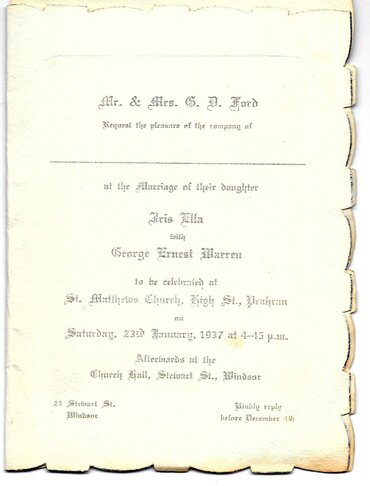
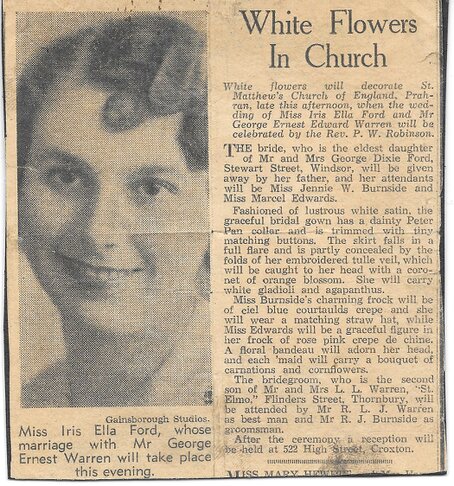
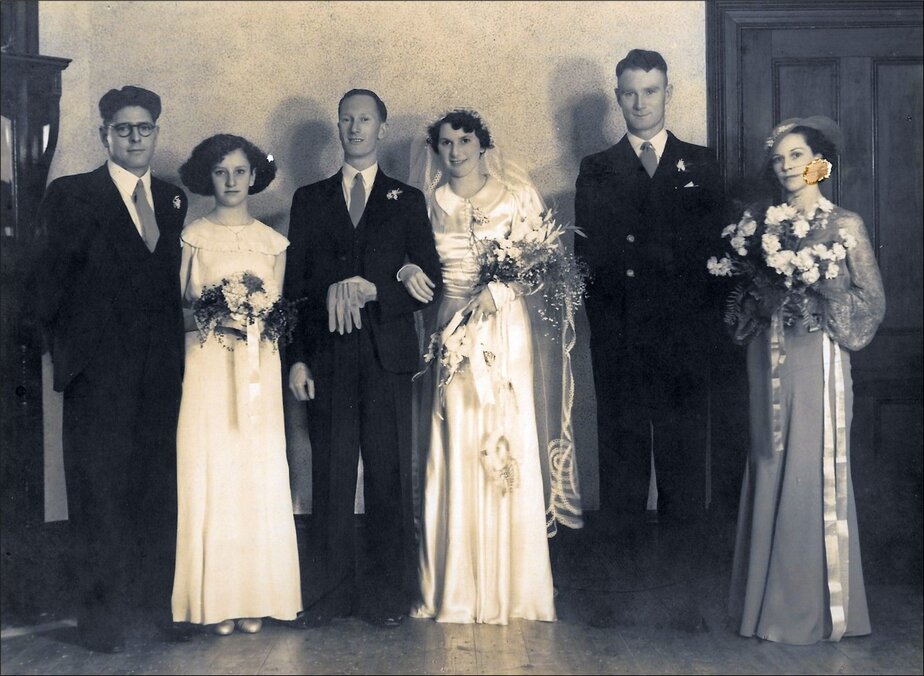
L to R : Bob Burnside, Marcel Edwards, George Warren, Iris Ford, Robbie Warren, and Jennie Burnside
Pretty soon, it was time for the groom and his bride to leave their guests and head off on their honeymoon. In the weeks leading up to her wedding, Iris was a bit short of money, so she decided to borrow a suit from her sister-in-law, Kath, to wear as her going-away outfit. Unfortunately, Kath was at least three sizes larger than Iris, whom the family had unkindly nick-named “Skinny Min”, so there was much adjusting and re-sewing to be done before Kath’s suit came anywhere near fitting Iris. But on the day, no-one noticed the extra darts and seams in the bride’s going-away outfit.
For their honeymoon, George took his new bride to a boarding house at 19 South Crescent, Westgarth, which was run by a woman named Mrs Fenny. George had originally planned to stay at Mrs. Fenny’s for a month after the wedding, and his journal records - “Paid in advance to Mrs. Fenny” .
But as it turned out, the honeymoon started Saturday night and finished on the following Monday night. It was the Australia Day weekend, so Monday was a public holiday and they both had the day off work! But first things first! Iris spent some of her wedding night unravelling the temporary stitches in Kath’s borrowed suit, so she could return it to Kath in good order! Then, on the Sunday afternoon, George walked Iris from their honeymoon boarding house in Westgarth to Flinders Street in Thornbury to visit his parents, Les and Burdett!
Back to work and Flinders Street, Thornbury
What with all the sewing and walking, their honeymoon was all too soon over! On Monday afternoon, the newlywed couple moved back to George’s parents’ house in Thornbury where they planned to spend the first few months of their married life. It was still very crowded at the Thornbury house as Kath and Bert and their baby son, Lennie, were still living in there, as was Robbie, who was by now engaged to Rene.
But at least Iris could escape from the little trundle bed and move out of the hallway!
As they started married life together, George was still working as a private detective with Philip Wade Private Investigating Services and was on an assignment at Henderson’s Springs in Alfred Street, North Melbourne. Iris was working as a tailor at L.L. Jackson in Melbourne.
Features of the Local Area
The local shops which Iris frequented included Lew Brothers in High Street, Thornbury, where she purchased her delicatessen supplies, and Nelson’s Variety Stores. Cyril Stevens Photographic Studio was also located in High Street, Thornbury and it was at this shop that Clara Hewitt worked for a period.
The family doctor was a Dr. Swain and his surgery in Dundas Street, Thornbury served the family for many years.
Public transport to the city was by cable tram and ran from the terminus at the corner of High and Dundas Streets in Thornbury. The cable tram service was discontinued at the end of 1941 and was replaced by a double-decker bus service.
1937, March - Household Furniture
Furniture was purchased from Paterson’s Pty. Ltd. for a total debt of one hundred and eighty-two pounds. George diligently recorded the payments against the debt in his journal each fortnight until February 1940, when the debt was totally repaid.
1937, July - Motor Bike
Another of George’s motor bikes - a Douglas TS model motor bike, was sold to Mr. Keith Edwards, a medical student at University of Melbourne for six pounds cash. An Overland car was purchased in its place.
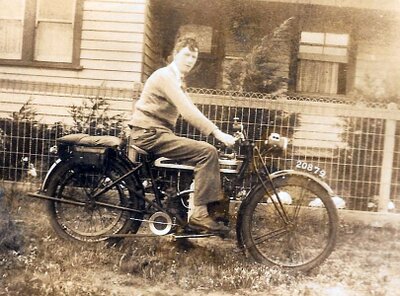
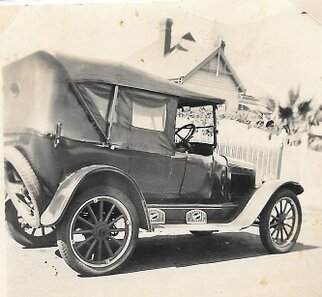
1937 - Pregnant with Bernie
Despite the sewing and walking of the honeymoon, within about five minutes of being married, Iris found herself pregnant with her first child. They were still living with George’s parents at Flinders Street, Thornbury and they found the lack of privacy was very difficult to bear as they also shared with George’s brother, Bert and his wife, Kathleen and their young son, Lennie. Photo shows Iris at the rear of her parents-in-law's house at 97 Flinders Street, Thornbury.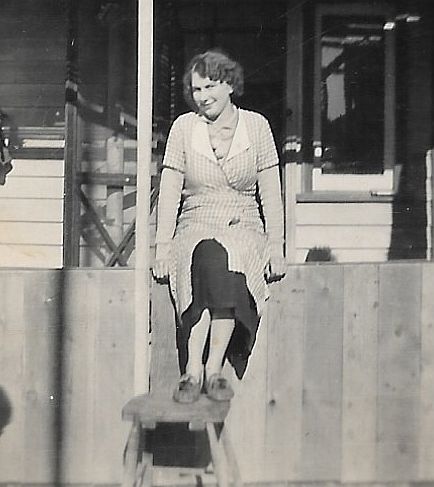

With so many crammed into the Flinders Street house, it was not surprising that George and Iris soon decided their priority was to get a house of their own. Iris, especially, found it very difficult living with her new parents-in-law.
So, to earn a little more money, Iris changed jobs and found a new position at an underwear manufacturer - Diamond Knitting Mills in Elizabeth Street, Melbourne.
When Iris applied for a position, they offered her a job on the button machine. However, Australia was still in the grip of the depression and married women were not encouraged to work as they took jobs away from single women - unless, of course, the man of the household was unable to get work.
Consequently, for Iris to find work, she had to pretend her name was still Miss Ford and hide her wedding ring in her pocket every morning before she got to work. Had it become known that she was married, she would not have been allowed to stay in the job.
But pretty soon, as nature took its inevitable course, her pregnancy became impossible to hide, and she was forced to leave.
1937, November 8 - Bernie born
In the early hours of the morning, their first child was born at Strathmore Hospital in David Street, Preston. The baby weighed eight pounds and four ounces, and they named him Bernard George Warren,“Bernard” because Iris very much liked the name, and “George” after George of course! Baby Bernie was a bonny fellow and Iris made all his clothes, just as her mother had done for her.
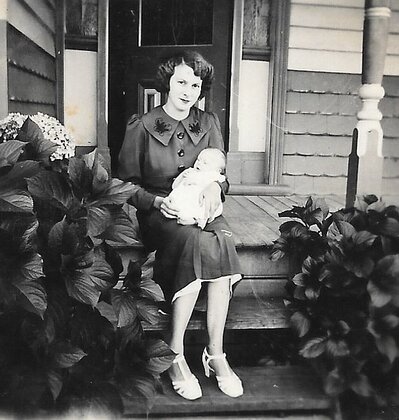
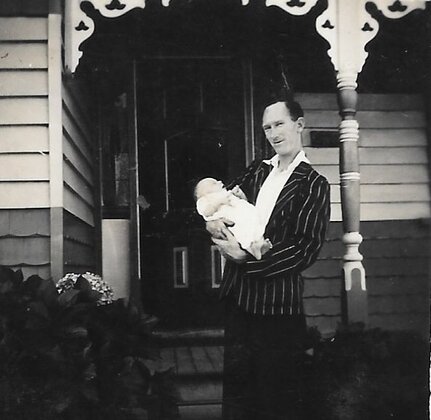
Proud New Parents, Iris Warren and George Warren with baby Bernie at 97 Flinders Street, Thornbury
Eventually, George and Iris had saved up enough money to purchase a home of their own.
1938 - Their First House - 25 Showers Street, Preston
A suitable house was found in Shower Street, Preston. It was a weatherboard house, on a small block, in a good position, close to transport and not too far from Flinders Street, Thornbury. Its price tag was six hundred and fifty pounds, with twenty-five pounds deposit and repayments of one pound per week.
All they had to do was to find twenty-five pounds for the deposit! So, with a bit of juggling, George’s prized Overland Car, registration No. 224.323, Engine No. 239160 was sold on February 21 for twenty-six pounds and ten shillings cash to Mr. A. Holmes of 24 Medway Street, Box Hill.
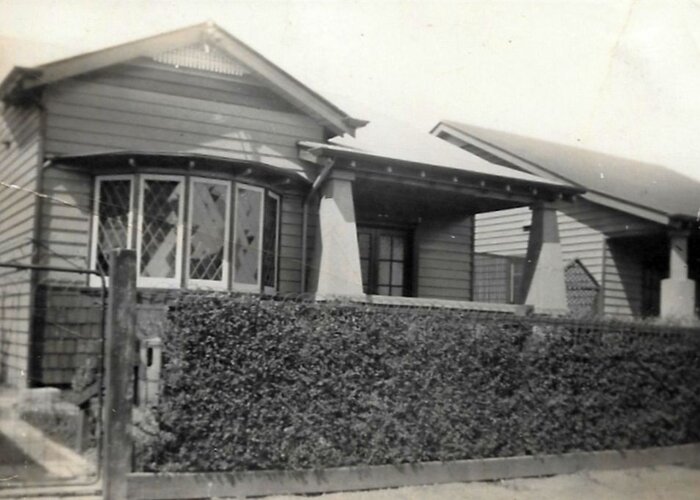
In their lovely little house in Shower Street, which they named “Warreford”, they at last began to experience the joys of married bliss - in private! Iris settled down to married domesticity with ease and enjoyed keeping house and cooking dainties for her new husband.
In the kitchen of their new home, they had a large black iron wood stove. Iris thought it was a beauty! She would cook wonderful cakes in it - beautiful rich fruit cakes and Christmas cakes. After she had finished cooking dinner in the evening, she would prepare the fruit cake and then pop it into the stove’s oven before heading off to bed. As the fire in the woodstove slowly burnt down overnight, the cake would slowly cook. Then in the morning - she had a perfectly cooked fruit cake - ready for George to take to work for his morning tea!
Perhaps Iris remembered the scathing criticisms George had made of his landladies when he boarded in Geelong. He had written to her (and she still has the letter to this day!) - “I think that I will shift into another boarding house because this place is getting a bit stale now. And besides, after you have been at a boarding house for a while, they start to get a bit lazy and you don’t get the same attention.”
Iris made sure she was not likely to be the target for similar criticism. She was so well organised she would get everything ready for each meal well ahead of time. She even set the breakfast table and had everything ready for breakfast before they went to bed the night before, including filling up the kettle with cold water and sitting it on the stove each night ready for their breakfast.
Now this went on for a long, long time. But one morning, she lifted the lid on the kettle to have a peep inside to check the level of water. Horror upon horrors! The top of the water in the kettle was swimming wall-to-wall with ants! How long had they been pouring them into their teapot every morning? They had no idea. But one must admit, it was taking rationing just a step too far. Still, it would be a fair bet that no-one asked for second cups of tea too often!
The toilet was fully equipped with pages from old telephone books, torn into convenient sized pieces, and hung on a nail on the wall. This arrangement was significantly upgraded at a later date when the newspaper pages, torn into four pieces, were threaded onto a heavy wire which was then hung from the nail!
A New Gas Stove - The mystery of the ants was not resolved until sometime later during a particularly hot summer. During the hot days, the little house was like a furnace as the wood stove was the only means of cooking. So, they decided to buy a modern gas stove. George cycled into Melbourne to buy the stove and arranged for it to be delivered and installed.
When the old stove was pulled out to make room for the new gas stove, what did they discover but a very active nest of ants installed under the old wood stove where it was dark, safe and warm!
Neighbours - In the period that George and Iris lived in Shower Street, they had good neighbours. On one side of them were the Williams family, and on the other side, the Weatherman’s. Across the road were George and Joyce Lediott, the Grant’s, the McCann’s, and the Shippick’s. There were also the Olsen family, the McFarlane family, the Waghorns and the de Blaquiere family.
1939-1945 - The war years
Melbourne joined in the national activity of ‘black-outs’ - no light was permitted to show from any house after dark. Wardens were appointed in each district, and they would patrol to make sure that every-one observed the black-out regulations. Curtains and drapes had to be pulled across windows before lights in the house were turned on, and the curtains were lined with black linen to damp out any escaping light. Light bulbs had to have one half painted black to limit the amount of glow they emitted. All these precautions were to reduce the chance of providing an easy target for any night-time enemy planes that may have been lurking in the night sky.
Air Raid Precaution Force
As George and Iris’ house in Shower Street was the only house in the street to have the telephone connected, George was appointed to the ARP - the Air Raid Precaution force. Harold Hewitt, who was living in Hakatere Street, Northcote with his family, was also a member of the ARP.
As a member of the Air Raid Precaution force, George had to do duty at the Wales Street State School in Northcote, watching for enemy aircraft. He also had to complete and submit “Air Raid Damage” forms from time to time.
1940 – Chrysler Super 66 Car
George’s car - a Chrysler Super 66, registration number CE.172 - which he purchased for one hundred and thirty pounds, had white stripes painted along the running-boards to help other drivers spot it at night in the darkened streets. It was also equipped with headlight black-out discs which, when required, were attached to the headlights, and permitted only a small circle of light to escape.
Rationing
George was also provided with a Ration Card that entitled the family to certain commodities and food, as these things were in short supply and therefore rationed in Australia at the time. The card was issued in March 1942 and records George’s address as 25 Shower Street, Preston. It also records his place of employment as Henderson’s Springs in Alfred Street, North Melbourne. Iris’ father, George Ford witnessed George’s signature and gave his address as 22 Stewart Street, Windsor. The ration card was for one child.
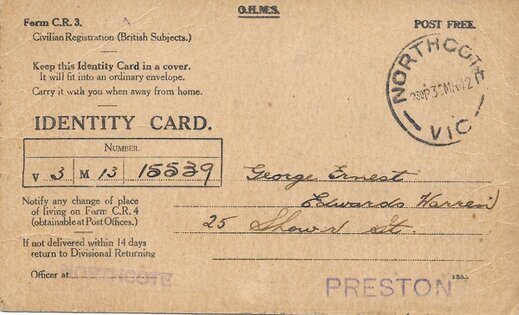
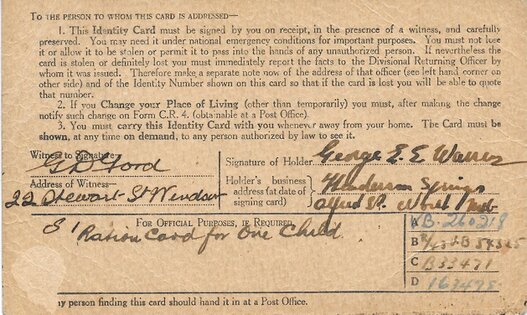
One of the items that was almost impossible to obtain, and which were not covered by the Ration Cards, was ladies’ stockings. So, Iris, like many other women at the time, painted her legs so it looked like her legs were prettily tanned!
Car tyres were also in short supply and were not covered by the ration system. When George needed a new set of tyres for his Chrysler car, he had to do a bit of fast footwork. He tracked down a builder who had the same make of car as George and who had a permit to purchase tyres. George then talked the builder into purchasing a new set of tyres which he then sold to George!
“The Manpower System”
During the war years, “The Manpower System” was a government run system that rated jobs in order of importance relative to Australia’s needs during the war. Once a person was appointed to a job in an area which was regarded as ‘essential work’, that person could not elect to leave to take up another job some-where else without permission. Iris was appointed to a factory which made uniforms for the Air Force - ‘essential work’ to the war effort and George was to remain at his work at Henderson’s Springs Works as an Ambulance and First Aid Officer.
1941 - A House Fire!
George and Iris decided to glass-in the front veranda of their house at Shower Street. This meant they had an extra ‘room’ which Iris could use for sewing or as an extra bedroom.
After Iris’s mother, Sarah’s death, Iris’ father, George, moved in with her and her family at Shower Street and the glassed-in veranda became his bedroom for a short time. However, one night, George dozed off with his lighted cigarette in his hand and set fire to the curtains in the little ‘room’. Poor George was quite distressed at his carelessness, but there was little serious damage, and it did not take long to put everything to rights again.
Not long after this incident, Iris’ father, George, moved to a boarding house in Morang Road, Hawthorn where he boarded with a lovely old lady called Mrs Kearns.
1941, February - Bernie has Diphtheria
Then, just what every parent dreads! Their baby son, Bernie, who was just three years old, became very sick and was diagnosed with the dreaded diphtheria. He was admitted to the Fairfield Infectious Diseases Hospital.
Neither Iris nor George was permitted to visit their baby son in hospital for many weeks during the early stages of the disease. Iris wrote constantly to the doctors and matron at the hospital to get news of her son’s condition and his progress and to seek permission to visit him. The letters she received in reply were coldly efficient and would have provided little comfort to the worried parents.
Bernie takes to the Drink!
It didn’t take long before the toddler was fully recovered and doing what all toddlers like best - exploring everything. One afternoon, Iris was in the kitchen with baby Bernie when there was a knock at her front door. She hurried to answer the knock and left Bernie to amuse himself on the kitchen floor. She had been gone for less than a minute when her attention was diverted from what the fellow at the door was trying to sell her. Terrible gurgling noises were coming from the kitchen. Frantically she rushed back into the kitchen, followed closely by the salesman, to find Bernie guzzling on a bottle of fly-spray which he had found in the cupboard under the kitchen sink.
A frantic trip to the local doctor’s surgery saved the day. But the poor salesman never had a chance. It was not one of his better days!
1942, February 11 - Death of Sarah Jane Ford
After a long and courageous battle against the asthma that had plagued her for almost all her life, Sarah Jane Ford died on February 11, 1942 at the Alfred Hospital.
1942 - Alan Hambleton - Tailor
When Bernie was about four years old, Iris was working as a ‘trouser-hand’ at Alan Hambleton’s tailoring shop in High Street, Preston, not far from the Circle Theatre. A “trouser-hand” was a term used to describe a sewing machinist employed in the manufacture of men’s trousers.
Each day, Iris would saddle-up her bicycle and with baby Bernie clinging for dear life on the rear passenger seat, cycle off to the kindergarten in The Anglers’ Club Hall in Murray Road, Preston. There she would leave Bernie in the loving care of the kindergarten teacher, Miss Roper, and then continue her journey to the tailoring shop for her day’s labour. Of course, each afternoon, she would be faced with the return trip.
1941 - Founding of the Northcote Division of St. Johns’ Ambulance Brigade
In July 1941, whilst George was still working at Henderson’s Spring Works, he completed a first aid course with the St. John Ambulance Association held at the Northcote Town Hall.
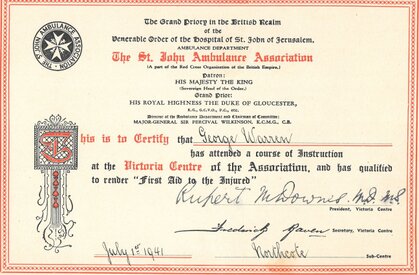
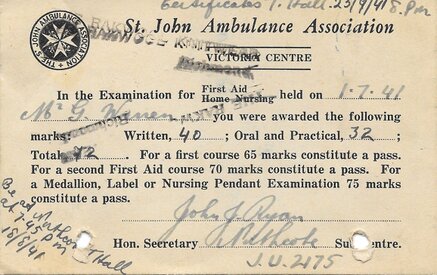
1942 – Henderson’s Magazine
He was soon appointed as the First Aid Officer at Henderson’s. His photograph appeared in the 1942 Henderson’s Magazine, as he plied his first aid skills on an injured workmate.
The text to the photograph read – The First Aid Officer renders first aid to a patient in Henderson’s hygienic and well-equipped First Aid Room. Such facilities are an essential requirement of the modern plant and demand the full-time duty of a fully qualified attendant prepared to handle ailments and injuries inherent with a large number of employees.
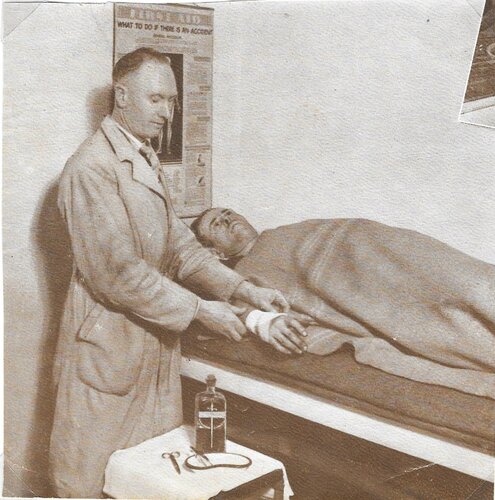
Shortly afterwards, he was part of a small group of men who formed the Northcote Division of the St. Johns’ Ambulance Brigade and he became a foundation member of the Division.
As part of the war-time precautions of the time, it became necessary for the St. Johns’ Ambulance Brigade to join with the Victorian Civil Ambulance Service. Consequently, in September of 1942, George was appointed Auxiliary Ambulance Driver No. 1025 and was issued with his official identification.
1942 – War Service
World War 2 was well underway. The Victorian State Emergency Services issued an identity card to George of 25 Showers Street, Preston as he had been appointed as an Auxiliary Ambulance Driver during the war years.
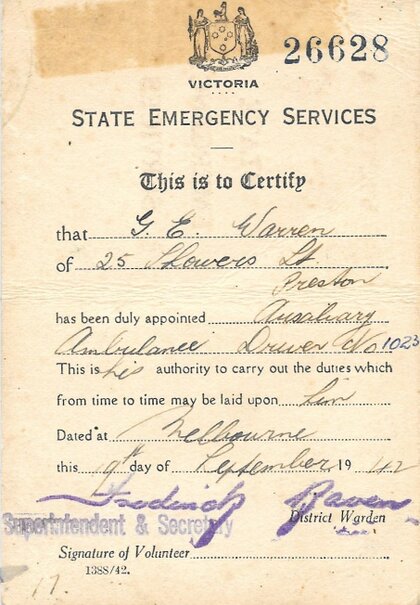
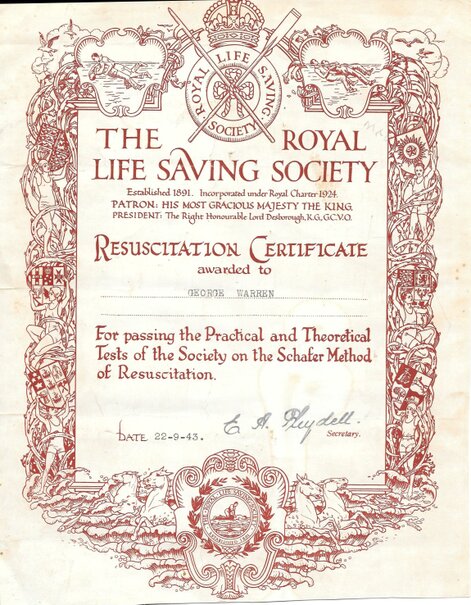
1943 – Royal Life Saving Society Certificate
George continued studying and improving his skills in first aid throughout this period and in September of 1942 was awarded a Resuscitation Certificate for passing the practical and theoretical tests on the Schafer Method of Resuscitation.
1946 - Warren & Sons
Early in 1946, George left his job at Henderson’s Springs Works. Here is his Certificate of Service. After nearly 10 years of service as a Records Clerk and First Aid Attendant, his reference is brief and to the point – Left of his own accord. Services Satisfactory.
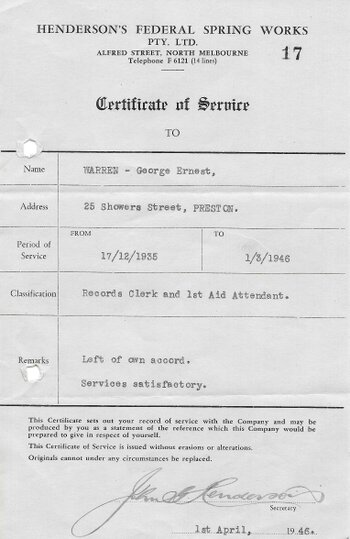
After leaving Henderson’s Spring Works, George, with his father, Les and his brother, Bert, set up a painting and decorating business which they called ‘Warren & Sons’. George had previously painted his house at Shower Street, and as a boy, had helped his Launder uncles and cousins in the painting business they had run from their shop at 720 High Street, Armadale. So, he figured, he had plenty of experience in the painting and decorating profession!
Pretty soon, their business was booming. They had a fleet of three vehicles, all beautifully sign-written and fully equipped.
The photos below show George and his father Leonard Leslie with their fleet and the bottom photo shows Bernie on his trike!
There was specially printed letter head for correspondence, invoices, and calling cards. This card was altered frequently to reflect changes in addresses and telephone numbers.
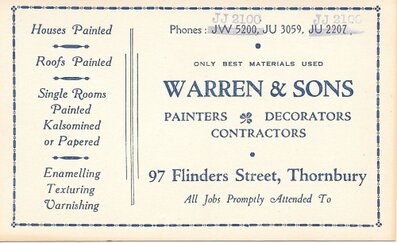
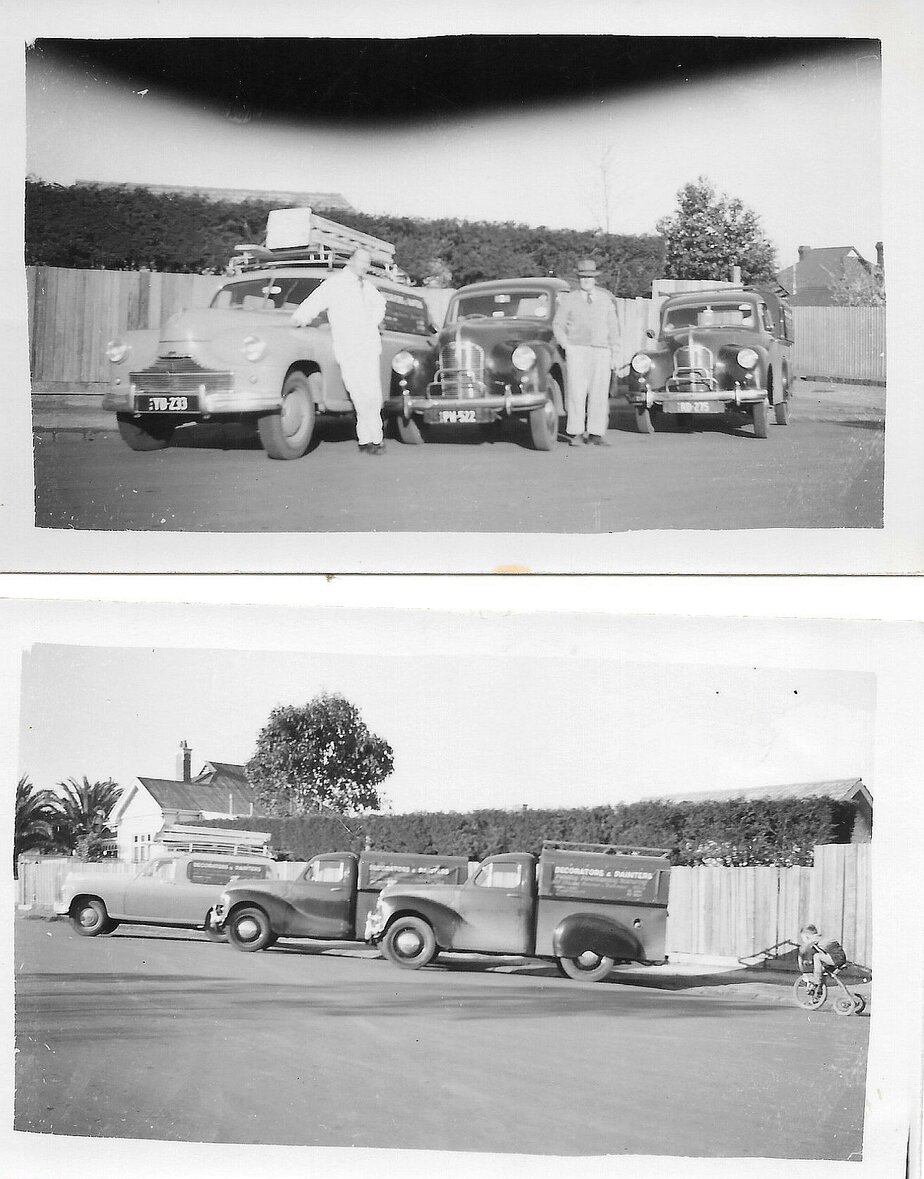
1945, November 6 - Nola born
On the day before Melbourne Cup Day in 1945, Kath and Bert’s son, Lennie, then aged ten, was instructed to run as fast as his legs would carry him to tell his Uncle George that Iris was about to have her baby. Luckily for Lennie, George was working at a house not too far from home.
After a frantic car drive from their house in Shower Street, Preston to the Airlie Hospital in Ivanhoe, during which drive George managed to run over and kill a black cat – what an omen for the new baby! - George and Iris’s second child was born the following day on Melbourne Cup Day, November 6, 1945.
The little girl was named Nola Irene Warren - ‘Nola’ because Iris had heard a song she had liked about a girl called Nola not long before her baby was due, and ‘Irene’ after her sister, Rene (Muriel Irene Ford).
Their new baby proved to be a difficult feeder and Iris found herself struggling with a constantly crying baby. About six weeks after the birth, Iris’ sister-in-law, Kath, visited and offered to give baby Nola her bottle-feed. After much spluttering and crying, Kath decided to take matters into her own hands and investigate the inside of the baby’s mouth.
“She’s tongue-tied!” exclaimed Kath. ”It is no wonder she can’t feed properly!”
So, a quick trip to the local doctor and a snip to the skin beneath the tongue which attaches the tongue to the floor of the mouth, soon solved the feeding problems and relative quiet was restored to the household.
Brother Bernie was permitted the responsibility of pushing the pram with baby Nola safely stowed up and down the footpath outside the house for several weeks after her birth.
1846 – First Wages’ Book for Warren & Sons
Warren & Sons employed several workers as painters during this time. Often, some of the Italian painters and their families were housed in the back verandah of George’s father’s house at 97 Flinders Street, Thornbury.
1947 - Madeline Street, East Preston
In about 1947, the family moved out of Shower Street, Preston and moved to a house that they had built at 40 Madeline Street, East Preston. It was a solid brick house and cost them one thousand and two hundred pounds.
Unfortunately, during the war years, cement was in short supply, so the mortar between the bricks had more sand and water than cement. A year or so after the family moved into the house, George noticed the mortar between the bricks starting to crumble, so he deemed it expedient to contemplate another house move.
1946-1947 - “Out-Door” Work
For some time, both before and after the birth of Nola, whilst the family was living at Madeline Street then later at 7 Arnold Street, Iris worked from home making trousers for a tailor. Her industrial power sewing machine - a “Singer” - was installed in the back veranda. It had a large timber work bench attached and the body of the machine was glossy black and was decorated with delicate designs and the maker’s name was painted in gold. The machine was operated by electricity and a forward pushing motion of the foot on the treadle engaged the electric motor which operated the sewing mechanism by means of a heavy leather belt.
Ten-year-old Bernie was safely off at school, but baby Nola was still at the crawling stage. Iris would string up a make-shift curtain around the bottom of her sewing machine to keep little fingers away from the sewing machine mechanism and the foot treadle. With one eye on the sewing machine needle flashing up and down close to her fingers, and one eye on the exploring baby crawling around her feet, it was a miracle that hundreds of pairs of men’s trousers were made by Iris during that time.
And just to complicate matters, her boss, Mr. Lucas, who ran a tailoring shop in Block Arcade in Melbourne, would telephone constantly to change his instructions. It was a regular event for him to telephone Iris and say - “I don’t need Mr. Scott’s trousers - I need Dr So-and-so’s trousers. Leave Mr Scott’s trousers and finish Dr So-and-so’s.” This was very frustrating when Iris had not even started Dr So-and-so’s trousers!
The completed orders would then need to be delivered to the railway station each night in order for them to catch the train parcel delivery service to Melbourne the next morning. Consequently, each night at about eleven o’clock, George would have to ride his bike to the railway station with Iris’ completed work bundled up in a neat parcel. Iris vividly remembers one such night, when she and George had “one hell of a row”. George was fed up with his nightly treks to the station! Iris was fed up having to work from eight o’clock in the morning until nearly eleven o’clock every night! Stress got the better of them both and Iris threw a heavy ruler at George! Luckily, her aim was not so good, and they both survived. But, for the sake of wedded bliss, Iris gave up her job with Mr. Lucas shortly after that eventful night!
Iris had another ‘out-door’ machinist job from a factory in South Melbourne. Every few days, Iris would tuck baby Nola safely into her pusher, and catch the tram to South Melbourne. She would then walk about a mile from the tram-stop to the factory to collect piles and piles of precut, but unsewn, plastic baby pants. There were layers and layers of ‘glad-wrap-like’ material, and she found that if she was not careful, she’d sew two together, instead of one. Iris was quoted a price per dozen pairs of these wretched panties, but as it turned out, she was only paid half the quoted price. It was not one of her most lucrative jobs!
She also worked for Alexander’s, the men’s wear store in High Street, Preston for a long time as an ‘out-door’ machinist. But, when the unions got strict on licenses, she was put off because she did not have a license to work at home. So, she went to the Trades Hall to get a license. One of the first things they asked her was - “Do you have a husband?”
When she confessed that she was indeed married, they refused to grant her a license. In protest, she said - “But, I need the money!”
Asked what she needed the money for, she replied - “I need a refrigerator!” But their answer was - “You can live without a refrigerator!” And they refused her application for a license to work at home.
1949 – Car Crash
In about 1949, George successfully re-arranged the panelling on one of his vehicles - a green Ford Prefect - Registered No. 166.851 - when he had a head-on collision with a brick truck in High Street, Preston. Luckily, other than George’s car, no serious injury was sustained. The Prefect was subsequently repaired but was then replaced by a sturdier vehicle - a Green and black Austin A40 Utility - Registered No. PW.522.
Not long after the purchase of this vehicle, the firm purchased a second identical vehicle for George’s father, Leonard Leslie Warren’s use – another Green and black Austin A40 Utility - Registered No. RD.275 Each of these fleet vans was equipped with a black waterproof canopy with clip-on “Warren and Sons” signs which could be easily removed whenever required.
“Warren & Sons” regularly changed-over its vehicles about every two years, and over the years, had many vehicles including Austin A40’s, Vanguards - Vanguard Panel Vans, Registered Nos. YO.233, GED.109m and GOL.330, and then later Holdens – one of which was Two-toned Green Holden Station Wagon, Registered No. HBB.500.
Bert soon decided to try his luck in other avenues of business, so George and Les continued to run Warren & Sons. They became well-known in the northern suburbs of Melbourne as a reliable and reputable painting firm. In about 1966, Les retired from the business and George continued until 1974, when he too, retired.
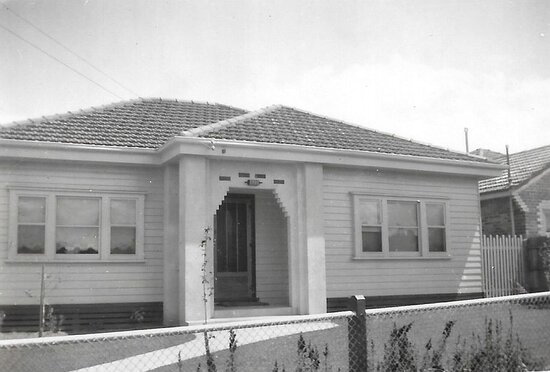
1949 - Arnold Street, Preston
In 1949, their new home was set up at 7 Arnold Street, Preston, a weatherboard, two bed-roomed house. The phone number was JU 3059.
The front entry hall was particularly roomy and functioned beautifully at the regular parties that were hosted at the house.
As was customary, the back veranda had been built-in with a skillion roof and a wall of louvre windows overlooking the back garden. A small room off to the side of the back veranda functioned as Bernie’s bedroom. Just outside the back door, was a fibrocement bungalow which was home to Harold and Clara’s son, Arthur and his new wife, Carol. (Clara Hewitt, nee West, was sister to Iris’ mother Sarah Jane West, and therefore Iris’ aunt).
During these years, George and Iris attended several balls – Iris made both the gowns seen in this photo – one for herself and one for her neighbour and friend Jean McLean. Jean’s husband was Jack, a warden at Pentridge Gaol. And this time the ball was The Police Ball.
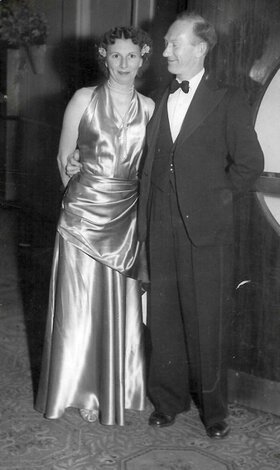
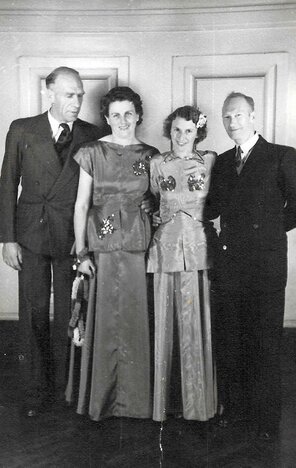
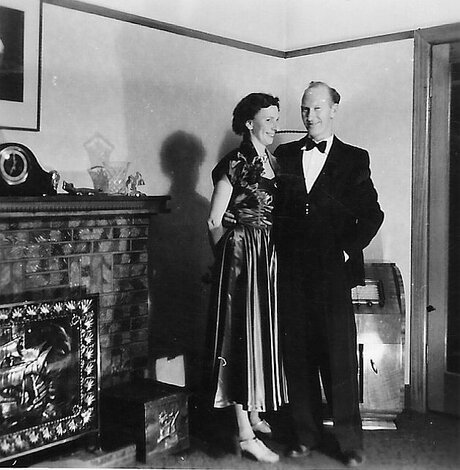
The Preston Locality -
The shopping strip in High Street, Preston included the newsagent which was run by the Gluyas’, and Lloyd’s where wonderful delicatessen items were available. Mr. Lloyd made fantastic pickle onion and lettuce sandwiches!
There was also a dimly lit grocery shop where Iris would shop. Just inside the doorway, there was a wide timber bench, behind which stood the grocer wearing his full-length white apron. Iris would rest her shopping basket on the bench while the grocer scurried around selecting the grocery items she wanted. Eggs were carefully placed in a brown paper bag, as were biscuits, flour and sugar which were all purchased by weight. Velvet soap was purchased by the block which the grocer cut from a large slab.
But progress caught up with the little grocery shop and in 1953 it was converted to the area’s first ‘supermarket’ - the “Coronation Supermarket”. Shoppers were no longer served but served themselves.
House Parties
With George’s brothers, Bert and Robbie both married, it became a tradition that they would take it in turns to host a party – usually about once a month or six weeks. The tradition of these parties started during the war years and continued until the mid-1950’s when television came to Melbourne and stifled the family closeness.
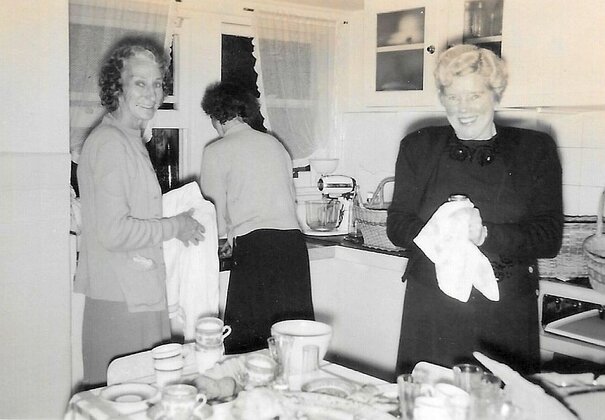
At these parties there would be music, singing and dancing, the men would bring their own supplies of beer and the women would bring a contribution to the supper that they would all enjoy at about eleven o’clock.
After a while, the men decided it was easier to have a keg of beer - a ‘niner’ (containing 9 gallons) or sometimes an ‘eighteen’ (eighteen gallons). This was delivered to the party house on the afternoon of the party. The keg was usually set up in the garage and was ceremoniously ‘tapped’ or opened at about four o’clock in the afternoon it was said just to make sure the beer was OK!
Iris became famous for her ‘Kai See Ming’, her beer-battered flake and her home-made sausage rolls which she prepared for the suppers. The photo shows L to R : Burdett Warren, Iris Warren at the sink, Kathleen Warren
George and Iris, as well as Kath and Bert, had pianola pianos. A special perforated paper roll was loaded into the pianola, and with much pushing and peddling of the foot pedals the perforated paper rolls would thread past a tube through which the peddling action would draw air. As air was drawn through each perforation, a corresponding piano key would depress, producing the correct note for the particular piece of music. As the evening wore on, people would take turns at peddling the pianola, as there was a corresponding decrease in music tempo as the peddler ran out of puff!
Everyone would gather round the piano and for the most part sing along with the song that was playing on the pianola, reading the song’s words which were printed on the paper roll as it wound around the tube. Some of the favourite songs were “Roll out the Barrell”, “It’s a Long Way to Tipperary”, “Jingle Bells”, “My Wild Irish Rose”, “Don’t Fence Me In”, and “Danny Boy”, along with dozens of others. Unfortunately, many of these parties ended in near brawls as the Warren brothers tended to bravado when loaded with alcohol. George was always known as the peacemaker but even he struggled to keep some of the riotous behaviour in hand many times.
Bernie and Nola’s Memories of Arnold Street, Preston
The following are just a small sample of the thousands of memories Bernie and Nola have of their childhood and are worthy of recording.
Piano Lessons - Iris seemed was determined that at least of her brood was to become an accomplished pianist. Bernie, being the elder, was the first to be subjected to piano lessons at Madeline Street. Firstly, a teacher by the name of Miss Kennedy was recruited to attend the house once each week to give lessons to the reluctant Bernie. Miss Kennedy wore a smelly tweed overcoat and hat which she secured with a large hatpin. As soon as she arrived, she would fossick in her handbag, extract an alarm clock and stand it on top of the piano to time the thirty-minute lesson. Her fee for each lesson was seven shillings and six pence. Regardless of the weather, Miss Kennedy always wore the same coat and hat and was never known to remove them!
When Miss Kennedy gave up the fight, her successor in the lost cause was a Mr. Scriven who gave piano and singing lessons from rooms at the back of shops in High Street, Northcote, and later in a house near Separation Street, Northcote. He was no more successful in his quest, although left to his own devices, Bernie could play quite well - ‘by ear’ - his speciality being “The Danube Waltz”.
With Bernie proving to be unworthy clay in the hands of the teachers, it was Nola’s turn. Again, a spinster in tweed, this time called Miss Courtney, took up the challenge. At first Nola was a reasonably enthusiastic pupil, but when as a reward for making mistakes in her scales she felt the crash of a wooden ruler across her knuckles, she too lost interest. And besides, the hour-long practice sessions each afternoon after school were terribly tedious when the sounds of other children playing in the street outside wafted through the window. Nevertheless, Iris was not about to give up. The services of the ‘Shefte School of Music’ were sought as they taught a short-cut method to the piano. But alas, they too failed dismally.
Learning to Drive - Prior to Bernie learning to drive, he rode his bicycle everywhere, with his trouser legs wrapped round his legs and secured with bike clips. Sometimes, George allowed him to sit in the driver’s seat of the family car and after carefully releasing the handbrake, he would be allowed to roll the car into the garage. However, one day, what with craning his neck to see over the top of the dashboard, concentrating on steering the car so that it cleared the garage doors, he forgot to brake in time and squashed Nola’s dolls and pram up against the workbench at the end of the garage.
Extra Pocket Money! - As time passed, Bernie was allowed to earn some extra pocket money by washing George’s Vanguard Panel Van. For this he was paid five shillings per week. But every time he washed the van, he would stick the hose up the exhaust pipe to see how much water it would hold! It was a wonder George was never troubled by the short life he had from the exhaust systems on this van. But apparently, he never noticed!
Iris’ Bike - In the meantime, Nola had to be content with her little tricycle and her red scooter. By the time she was about eight, she decided to graduate to Iris’ large two-wheeler bike. She taught herself to ride by balancing against the side wall of the house. Many, many hours and countless scratches, bruises and bumps later, she could ride, only to be told she was too young to ride the bike in the street, so she had to be content to ride up and down the driveway.
Sunday Schools - Iris also tried to ensure that both Bernie and Nola received the benefit of a religious education. Bernie attended the South Preston Methodist Church in Yann Street, where he remembers accidentally dropping the penny he had for the collection plate and having to watch it roll across the floor and then see it disappear between the floorboards.
Nola, on the other hand, had a slightly different recollection of Sunday School collections. Ian McLean, a neighbour, would walk her to the Church of England in High Street for Sunday School. One morning, Ian suggested she pull the large brown button off her coat and substitute it for her penny when the collection plate came around. Then they could spend the penny on lollies before they got home. So, whilst singing the little song “Hear the Pennies Dropping for Jesus”, Nola tugged at the button and dropped it into the plate. The lollies were great, but not so Iris’ annoyance at the lost button.
Dancing Lessons - Nola dreamed of being a ballerina dancer, so Iris arranged for her to take lessons, but alas, not in ballet, but in tap dancing! It was probably at this time that Nola’s stubborn streak first became apparent. At the hall in High Street where the lessons were given, Nola refused to move a muscle, regardless of what inducements were offered. The poor teacher even knelt down on the floor and attempted to move her feet with her hands! But Nola had decided that tap dancing was not what she had had in mind.
Pets - There were also the pet rabbits which Nola kept in the canary aviary that George had built on the side of the garage. And the two roosters, Heckle and Jeckle, who lived in the screened-off woodshed at the back of the garage. These roosters became very aggressive and when one day they chased Nola all the way up the back garden to the back door and then attacked her legs, their number was up! They were soon found “a new home”! Or maybe that should read “a new stew”!
Miscellaneous Memories - Bernie remembers George walking down Madeline Street on his way home from work each evening, carrying a Gladstone kit-bag and wearing a belted leather overcoat in the cold weather, and walking with that distinctive ‘side-to-side’ swing in his gait. Also, the death of the family Pomeranian dog in St. George’s Road. And dinks on the red-tyred bicycle in Railway Place near Shower Street, which was surfaced with broken bricks and brick dust from the nearby Clifton Brickworks. He also remembers Bert making home brew in his bathtub and Arthur’s motor bike and getting rides on the back (Arthur was Iris’ nephew, his mother was Clara Hewitt). Bernie attended the St. John’s Ambulance functions as a cadet in a grey and black uniform with a silver St. John’s badge.
Nola remembers her father’s kitbag at Arnold Street, spattered with droplets of paint and smelling of old-fashioned putty. Also, her father’s belted gabardine overcoat, the white all-in-one painting overalls, which Iris would wash until they were gleaming white. The cut-throat razors kept in the bathroom cupboard and the leather strop which used to hang behind the bathroom door. The smell of the paint and putty in the back of the panel vans and the off-cut rolls of wall-paper with which she got to cover her school books and the flour and water glue George made to use instead of “Clag”. The dress-making and sewing lessons on the “Singer” sewing machine in the back porch and Iris’ home-made ice-cream. Aso the bread-dough sculptures that Iris made and the two concrete washing troughs in the laundry with the green and cream “Amco” hand wringer set up between.
1950’S - Cards at Harold and Clara’s
George and Iris continued to keep in close touch with Harold and Clara Hewitt. And for many years, every Friday night, up to twenty people would gather at the Hewitt’s Hackateer Street house for a game of cards, followed by supper. Bernie was old enough to be left at home on these nights, but Nola was dragged along and put to bed in the main bedroom until the night drew to a close.
1952 – Superintendent of St. Johns’ Ambulance Brigade
In 1952, George was appointed Superintendent of the Northcote Division of the St. Johns’ Ambulance Brigade. This was quite an honour for George as a founding member of the Brigade. Then inj 1954, he was appointed Divisional Superintendent of the Northcote Brigade of St. John Ambulance.
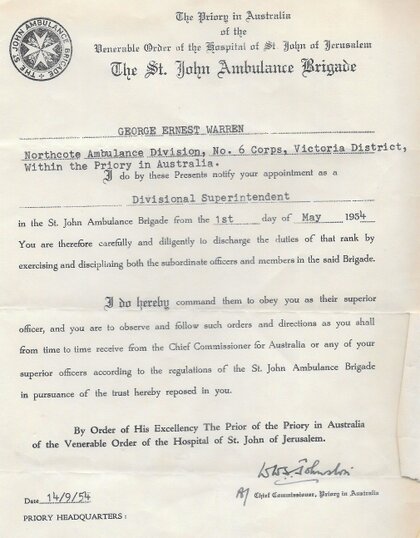
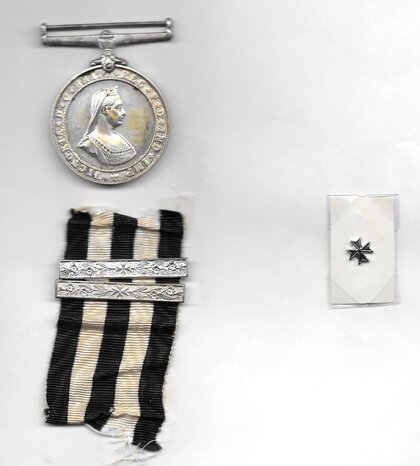
He was also awarded the Silver Service Medal by Sir Dallas Brooks, Governor of Victoria at a special ceremony. As part of his duties, George had to organise ambulance officers and cadets for attendance at league football matches, and various other public and sporting functions.
1954 – Parade through Melbourne
As Divisional Superintendent of the Northcote St John Ambulance Brigade, George leads his group in a parade through the streets of Melbourne.
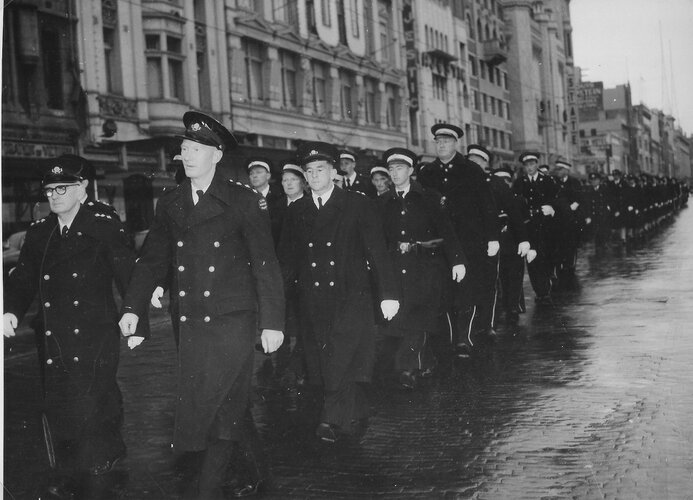
George leads his Division
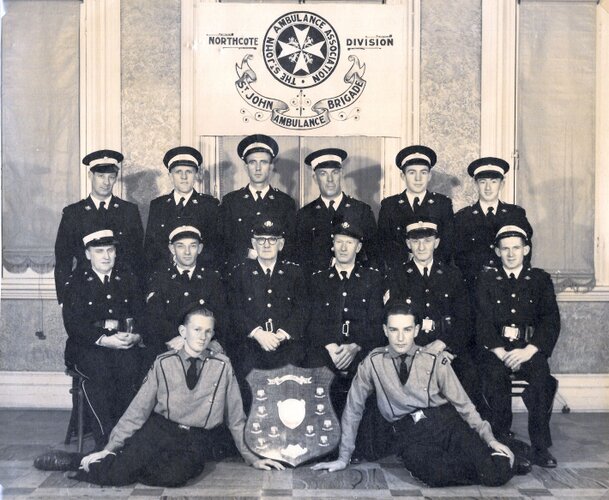
George sits 3rd from right with son Bernie sitting at left
1954, March 8 - Queen Elizabeth the Second’s Visit to Melbourne
One such function was on held March 8, 1954 when Queen Elizabeth II visited Melbourne as part of her Australian trip.
As a Divisional Superintendent of the Brigade, George was nominated to form part of the Guard of Honour at the Exhibition Buildings for the State Reception held in the Queen’s honour.
On this memorable occasion, George was introduced to Her Majesty and solemnly shook her by hand. It was more than a week before the Velvet soap came anywhere near his right hand!
1954 - Filming of “On The Beach”
1954 was a big year for George! It was also the year that Melbourne was used as the location for the filming of the Hollywood film “On the Beach” which starred Gregory Peck and Ava Gardner.
George was on duty at a public function at Olympic Park, when one of his cadets who was also on duty spotted Gregory Peck nearby. Desperate to get the film star’s autograph, the cadet rummaged in his pockets for a pen, only to come up empty-handed. George pulled his own pen out of his pocket and loaned it to the young cadet, upon which, the cadet rushed away in the direction of the film star. The young cadet soon emerged from the fray triumphant with an autographed paper in one hand and George’s pen in the other. Years later George still had the pen that Gregory Peck used to sign the cadet’s paper!
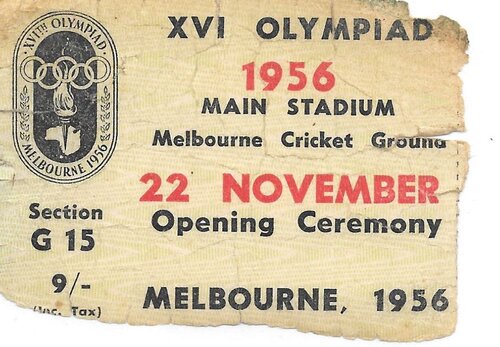
1956, November – Olympic Games come to Melbourne
Of course, George was on duty at the Olympic Games in 1956 and was provided with Duty Passes and Admission Tickets, especially to the Opening Ceremony.
1956/1957 – Springvale Road, Springvale
Perhaps the business of Warren & Sons was not bringing in sufficient income to fund both George and Iris’ needs as well George’s father’s needs. George’s father, Leonard Leslie Warren had retired from the business as he tended to be rather bluff and rude to customers, but he was still kept on the payroll. Whatever the reason, the idea of purchasing two shops – one a general Milk Bar and the other a delicatessen side by side at 13 and 14 Springvale Road, Springvale North at the corner of Springvale and Dandenong Roads, was deemed a good move for both George and Iris and George’s parents, Leonard Leslie and Burdett.
Burdett seemed the only one of the four who deeply regretted leaving her home at Flinders Street, Thornbury to set up house in the rear of the two shops.
At the time, the two shops stood alone at the edge of the rough Springvale Road, surrounded by paddocks and not much else. There were a few houses scattered here and there whose occupants were the only regular local clientele to the shops. The balance of the shops’ trade came from the occasional passing traffic who could be bothered to stop.
The accommodation behind the shops was very basic with the toilet in the back serviced by the night-cart man who called now and then to remove the filled toilet cans and replace them with empty ones.
Bernie was working in Melbourne at this time, and George was forced to resume his work with Warren & Sons to help with boost their income. As the firm had been disbanded for a time with expectations that the shops would provide sufficient income for both families, it was necessary to re-establish credit ratings in order to purchase raw materials so George could re-start the business.
As George left Springvale very early each morning to travel back to the northern suburbs to resume his painting business, it was left to Iris to ‘man’ the shop from 7 am until George returned in the evening to take over whilst Iris prepared dinner. Nola attended the Springvale North State School, and after school she took her turn to serve in the shop as did Bernie at weekends.
George said the books had been fudged when he purchased the shop, exaggerating the cash flow which, together the fact that the local customers ran up credit and rarely paid, it became necessary to sell the shops at a heavy loss. Both families returned to the northern Melbourne suburbs with much less cash than when they had left little more than a year earlier.
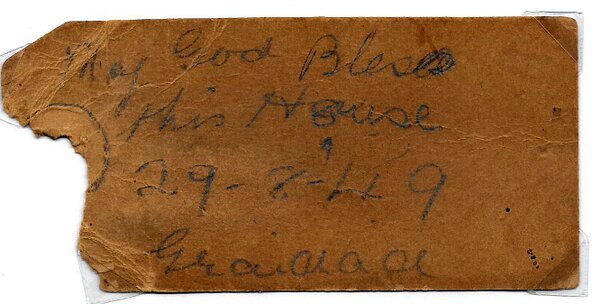
1958 – House Blessing – 129 Collins Street, Thornbury
George and Iris moved into their new home at 129 Collins Street, Thornbury after their failed attempt at keeping shop at Springvale. Iris’ father, George Dixie Ford gave his blessing on their house, dated February 3, 1958.
George’s parents, Leonard Leslie and Burdett purchased a small house at 4 Rayner Court, West Preston.
1960 – 10 Henty Street, Reservoir
The house at Collins Street, Thornbury did not suit George and Iris, so another move, this time to 10 Henty Street, Reservoir. Phone Number 46.2433. An updated business card was also produced for new address.
George resumed his work at Warren & Sons and life continues.
In 1960 George transferred to Reserve in the Ambulance Brigade.
A year later in 1961, his son, Bernie married Joan Scott at the Methodist Church in Mt. Alexander Road, Flemington.
Then George and Iris welcome the birth of their first grandchild in 1962 - Bernice Warren, a child for Bernie and Joan. In the same year, George received his Silver Star from the St. Ambulance Brigade.
In 1964 whilst George was at home at 10 Henty Street, Reservoir he heard that a man working in a trench a few doors away had fallen unconscious. George raced to the scene, pulled the man from the trench and performed resuscitation until the ambulance arrived. The man recovered fully.
Bernie and Joan produced their second baby in 1964, Glen Warren.
In 1965, George and Iris's daughter, Nola Irene Warren married Winston Basil Kim at the Methodist Church in Bruce Street, Reservoir.
On February 22 in 1966, Nola and Winston's first baby, Jeffrey David Kim, arrived. Also, in 1966, George and Iris sailed off on a cruise on board the "Flavia" - the first of many cruises to come.
Another house move, this time to 227 Greenwood Drive, Bundoora in 1967, phone 467 2627 followed by another cruise, this time on the "Ellinis", accompanied by Rene and Robbie
1969 saw the birth of their fourth grandchild, Katrina Kim.
Unfortunately, George's mother, Burdett Warren was admitted to Mont Park Asylum on May 23, 1973. That same year, with Burdett having been admitted to Mont Park Asylum, George’s father, Leonard Leslie was living alone at 4 Rayner Court, West Preston. So it was agreed that George and Iris would purchase the house at 4 Rayner Court, West Preston, and renovate it to suit their needs and to accommodate Leonard Leslie as well as themselves. George continued to work as Warren & Sons.
But by 1976 with failing health, George at the age of 61 years retired from Warren & Sons.
And 1977 saw their 40th wedding anniversary.
A family reunion was organised in 1978.
In 1979, Iris, who had been born in London, decided to take the leap and have herself naturalised as an Australian citizen.
Another house move, this time to a unit in Chelsea in 1980.
In 1986 George and Iris travelled to UK to several weeks with Nola and her second husband, Feargus Niall.
1983 was a big year - April 23, their granddaughter, Bernice Warren was married. In August, George’s 70th Birthday was celebrated at the RACV Club in Melbourne with his family, and grandson, Glen Warren joined the Victorian Police Force.
1985 in January, their first great-grandchild was born - Aimee Elizabeth; in November, their daughter, Nola's second marriage; and they moved to Chelsea.
1986 their grandson, Jeffrey David Kim was invested in Australian Navy and he later became engaged to marry Anita Grace Bellett.
1987 on January 23, they celebrated their 50th Wedding Anniversary. In September of 1987 their grandson, Jeffrey David Kim married Anita Bellett in Castlemaine.
1988 they had a wonderful 'second honeymoon' at the Queenscliffe Hotel. And in February their great-grand-daughter, Kirstie Grace Kim was born. And also in 1988 they moved to a cute little cottage at 25 Parker Street, Castlemaine to be near their daughter, Nola who was living in Castlemaine at the time.
And in 1993, they accompanied Nola and her daughter Katrina on another cruise, this time on the "Fairstar".
1997 was their 60th Wedding Anniversary and they moved to a unit at Portarlington, however, George suffered injuries there when his vehicle rolled backwards as he was getting out. He spent some time in hospital, but never properly recovered.
In 1998, it was decided that they should move to a retirement village, Tannoch Brae, in Geelong where there were services to aid them.
In 2002, they celebrated their 65th wedding anniversary at the Wool Exchange Hotel in Geelong. But later that year, George fractured his femur and after an operation and another stay in hospital, was transferred to the Grace McKellar Rehabilitation Facility in Geelong.
Shortly afterwards, he was again moved to the Geelong and District Nursing Home where he was visited by Iris daily.
However, at the age of 89 years on August 1, 2003, George passed away as a result of an infection in his ear worsening. Unfortunately, antibiotics were of no use as his kidneys could no longer cope.
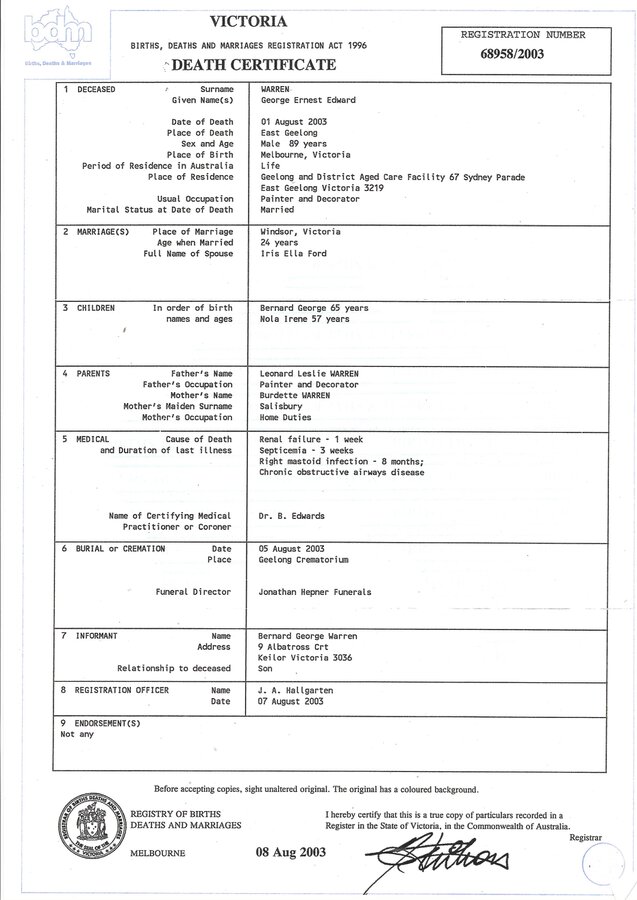
2007 – Death of Iris
Iris, aged 91 years, passed away at Hamilton Nursing Home.
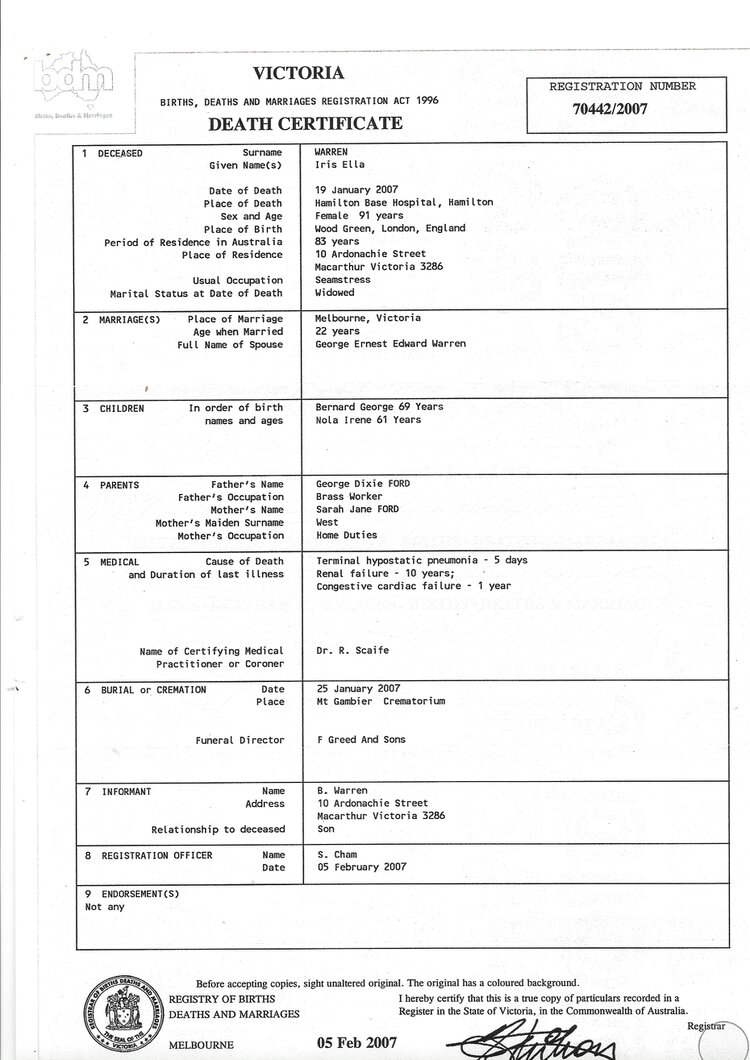
There is so much for to the lives of George and Iris Warren - bowling, holidays, cruises, Body Corporate Secretary at Chelsea units, however, I will close here.
MORE PHOTOGRAPHS -
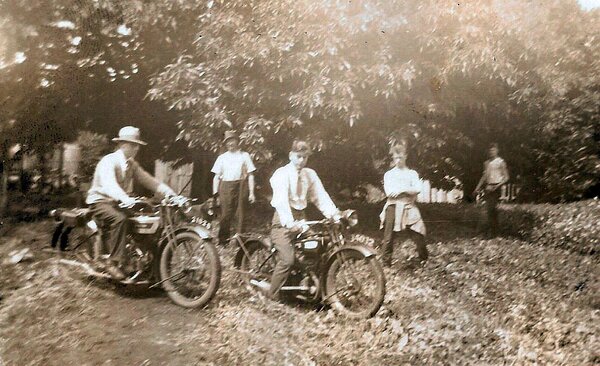
George and mates with motor bikes
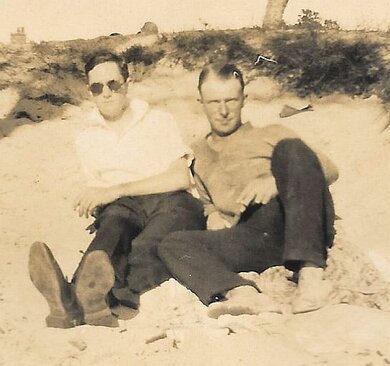
George and his cousin "Tiny" Launder
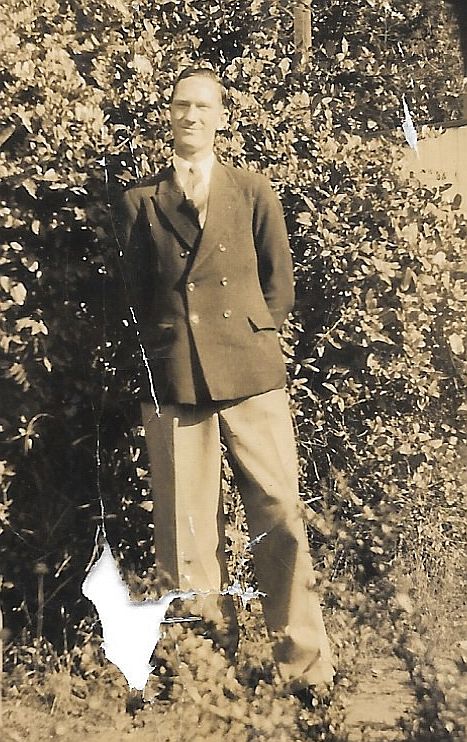
1933 - George about to go on a date
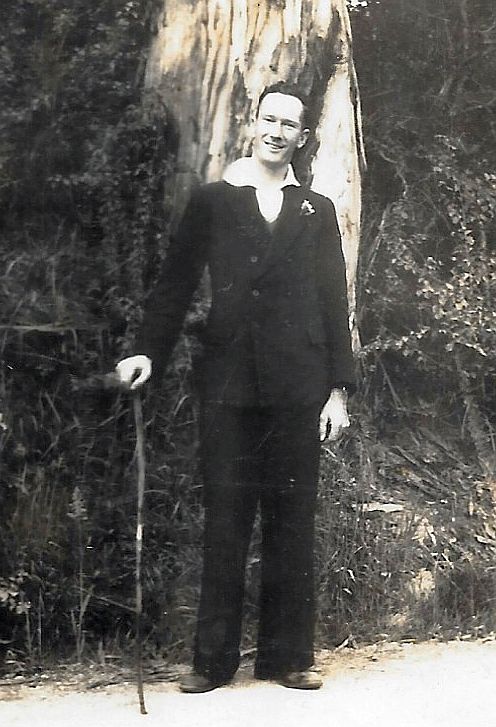
1934 - George out walking at Warburton
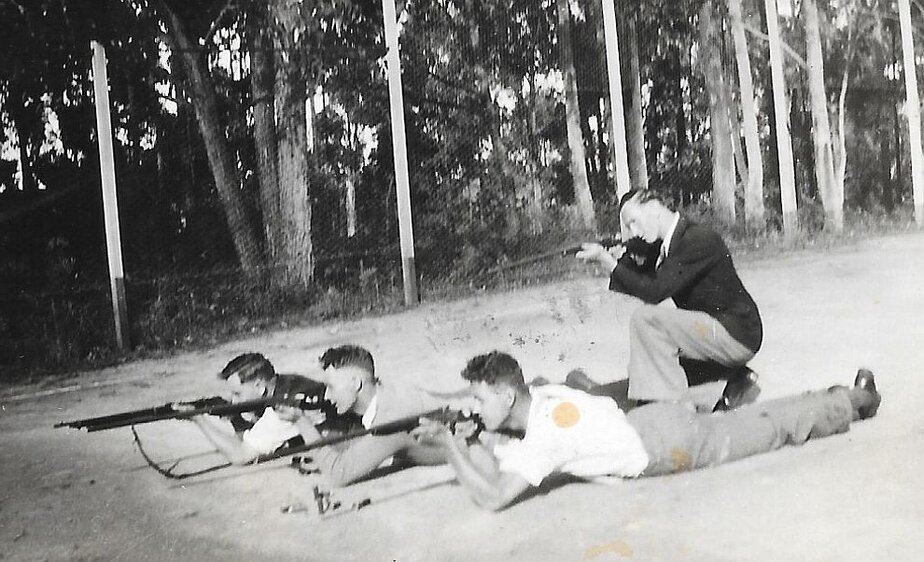
L to R : Unknown, Robbie Warren, Harold Hewitt and George kneeling
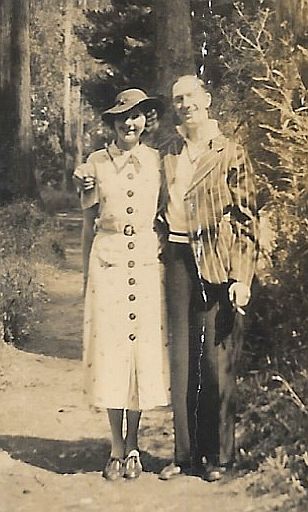
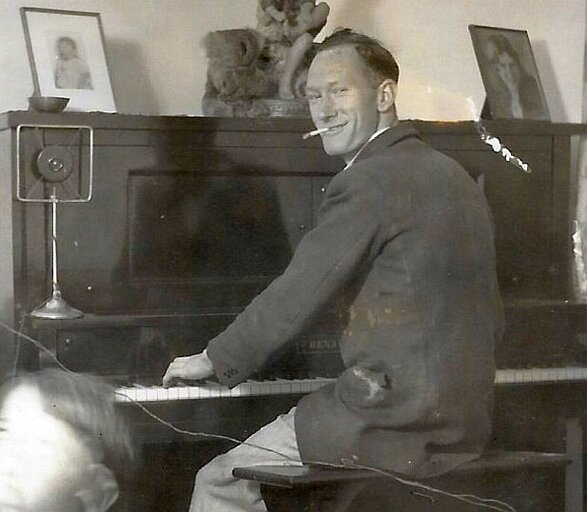
L : 1936 Iris and George out walking R : 1936 George playing the piano at 97 Flinders Street, Thornbury
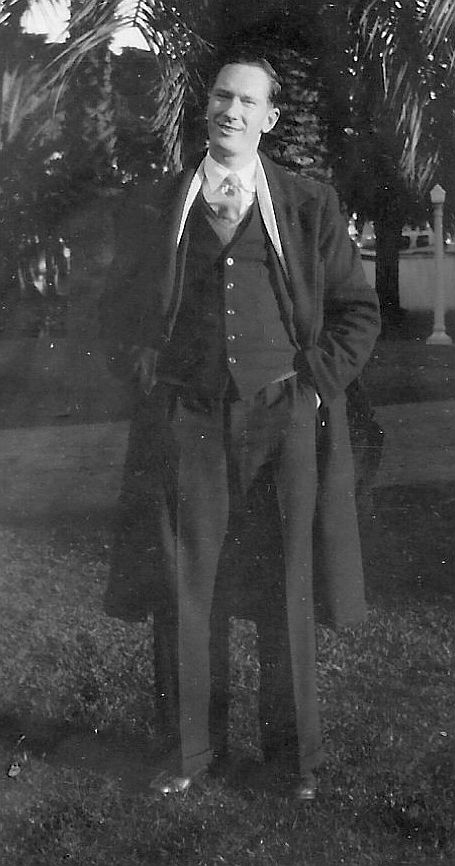
1935 Dapper George in the Botanical Gardens
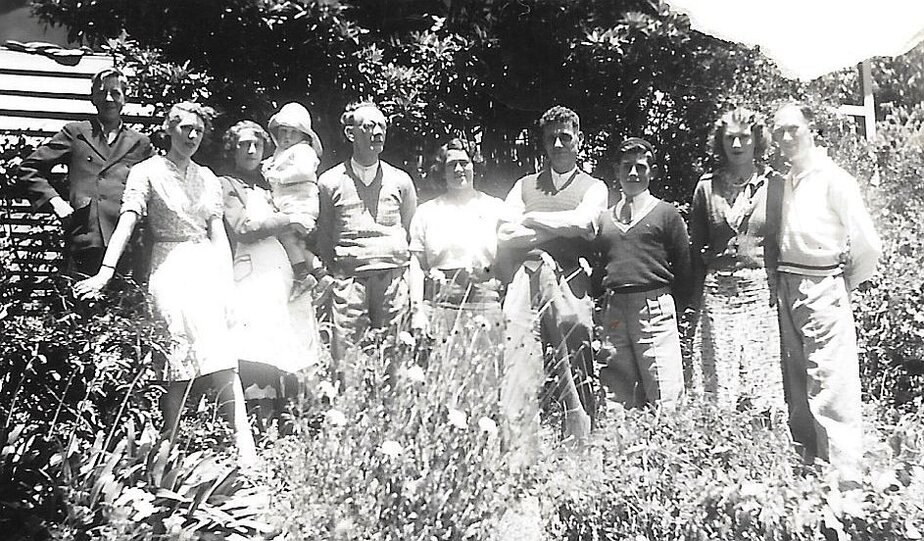
1938 L to R : Arthur and Unis Hewitt, Sarah Ford holding baby Bernie, George Ford, Clara and Harold Hewitt, unknown, Iris and George Warren
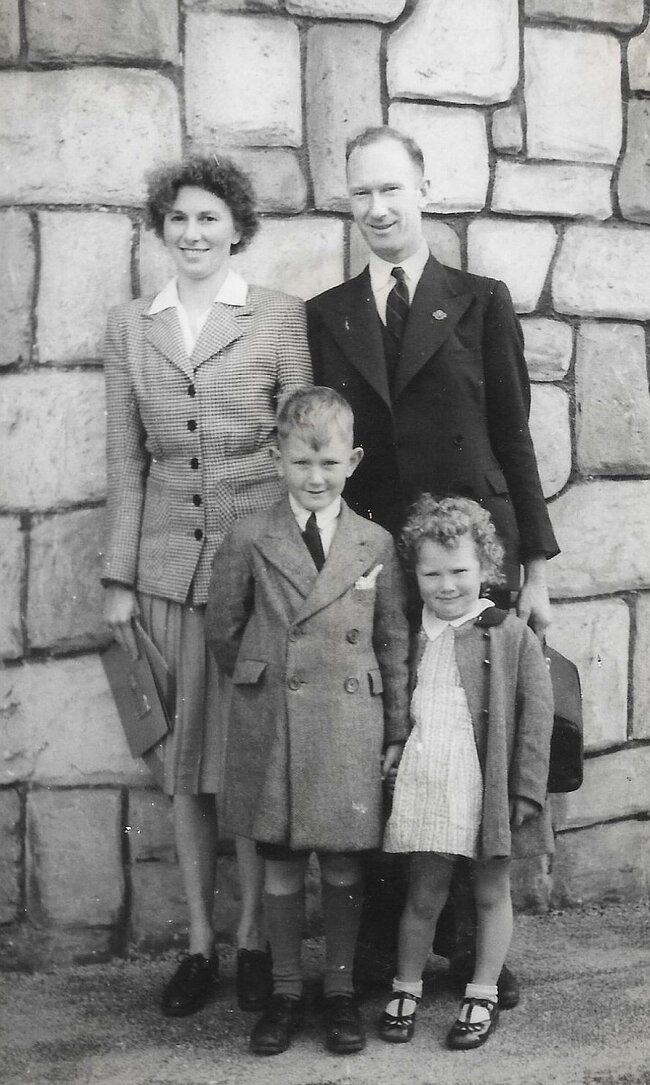
About 1944 : Iris and George with Bernie and neice, Beverley Iris Warren
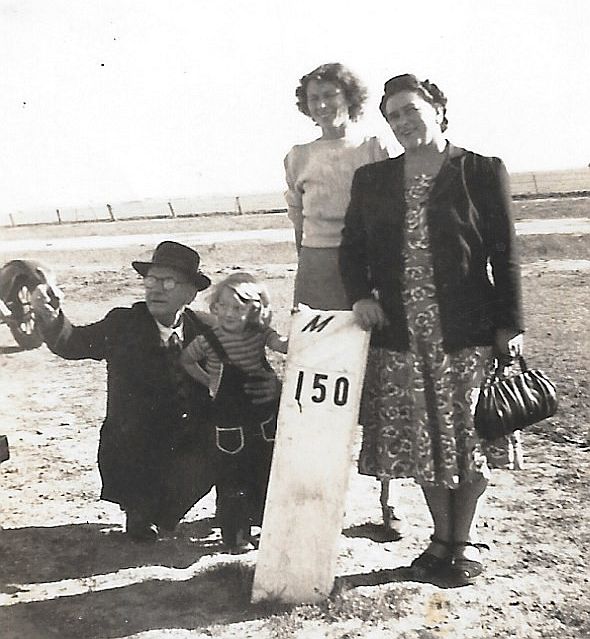
About 1948 : George Ford with Nola, Iris Warren & Clara Hewitt
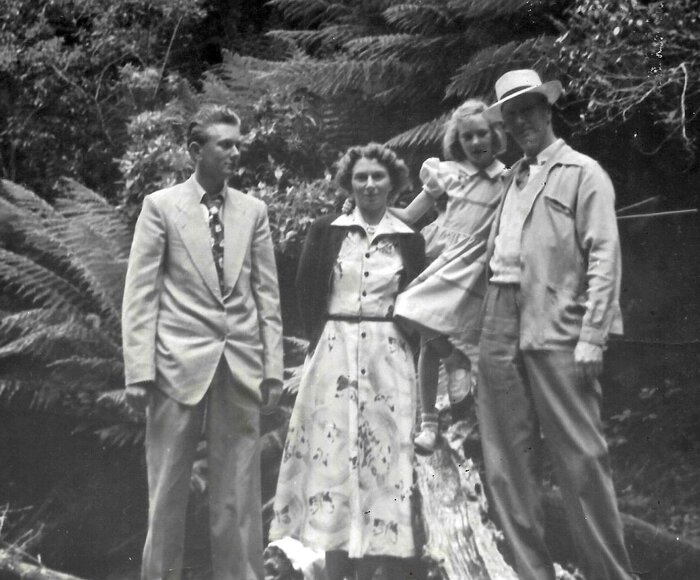
About 1951 : L to R Bernie, Iris, Nola and George Warren
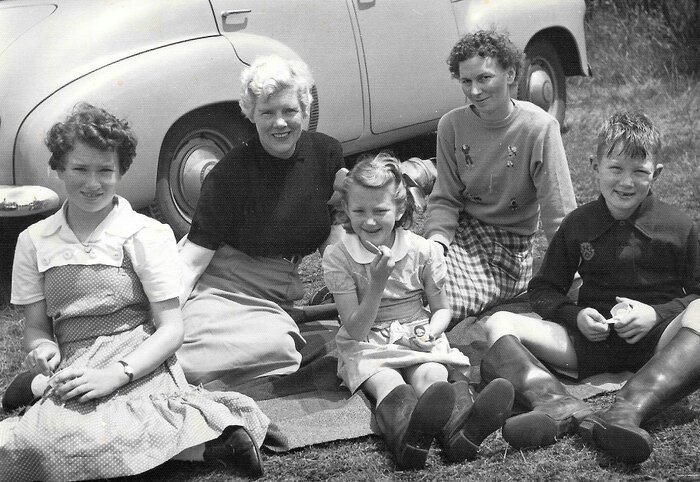
About 1952 : L to R Beverley, Kathleen, Nola, Iris and Robert Warren

